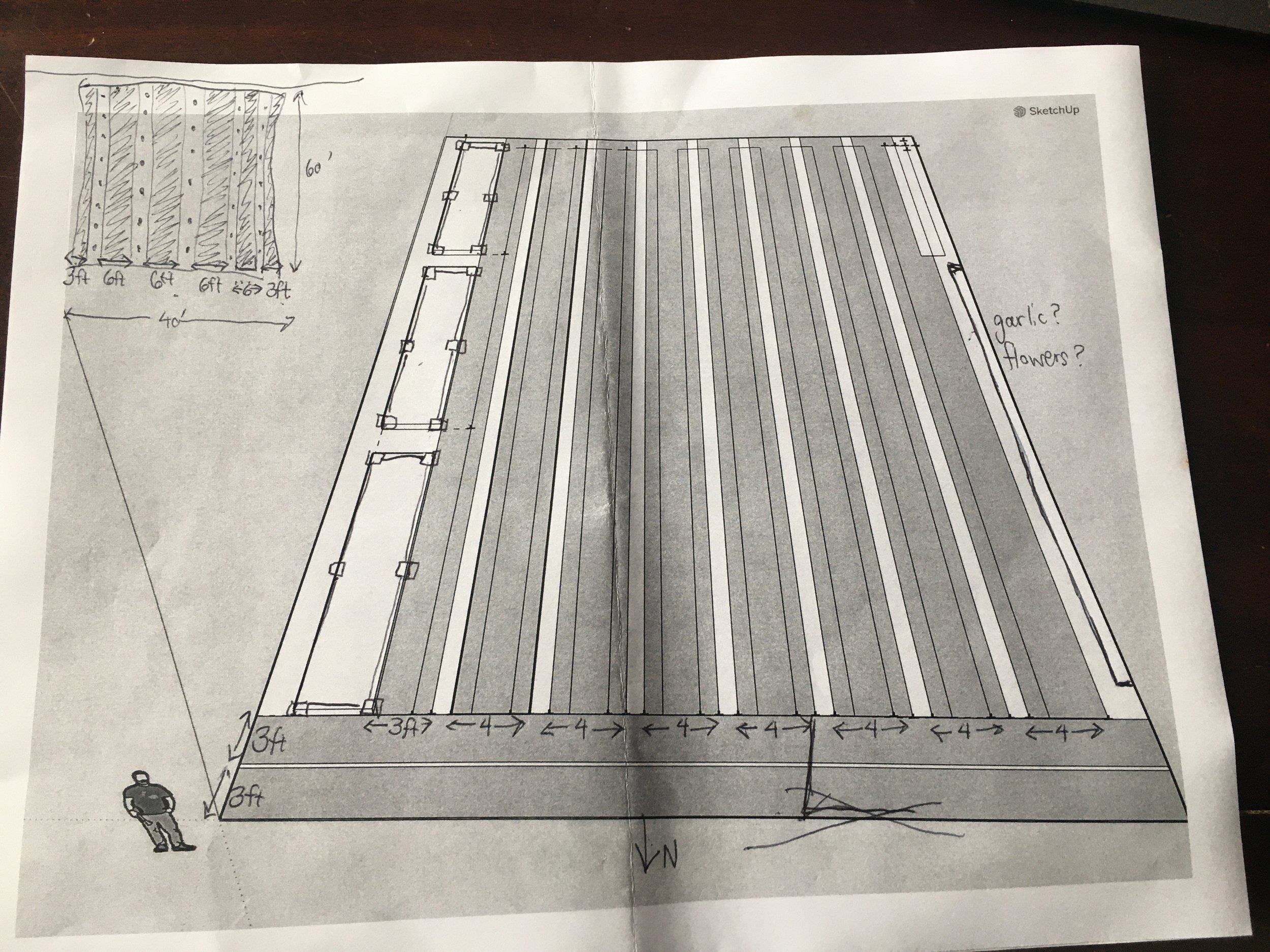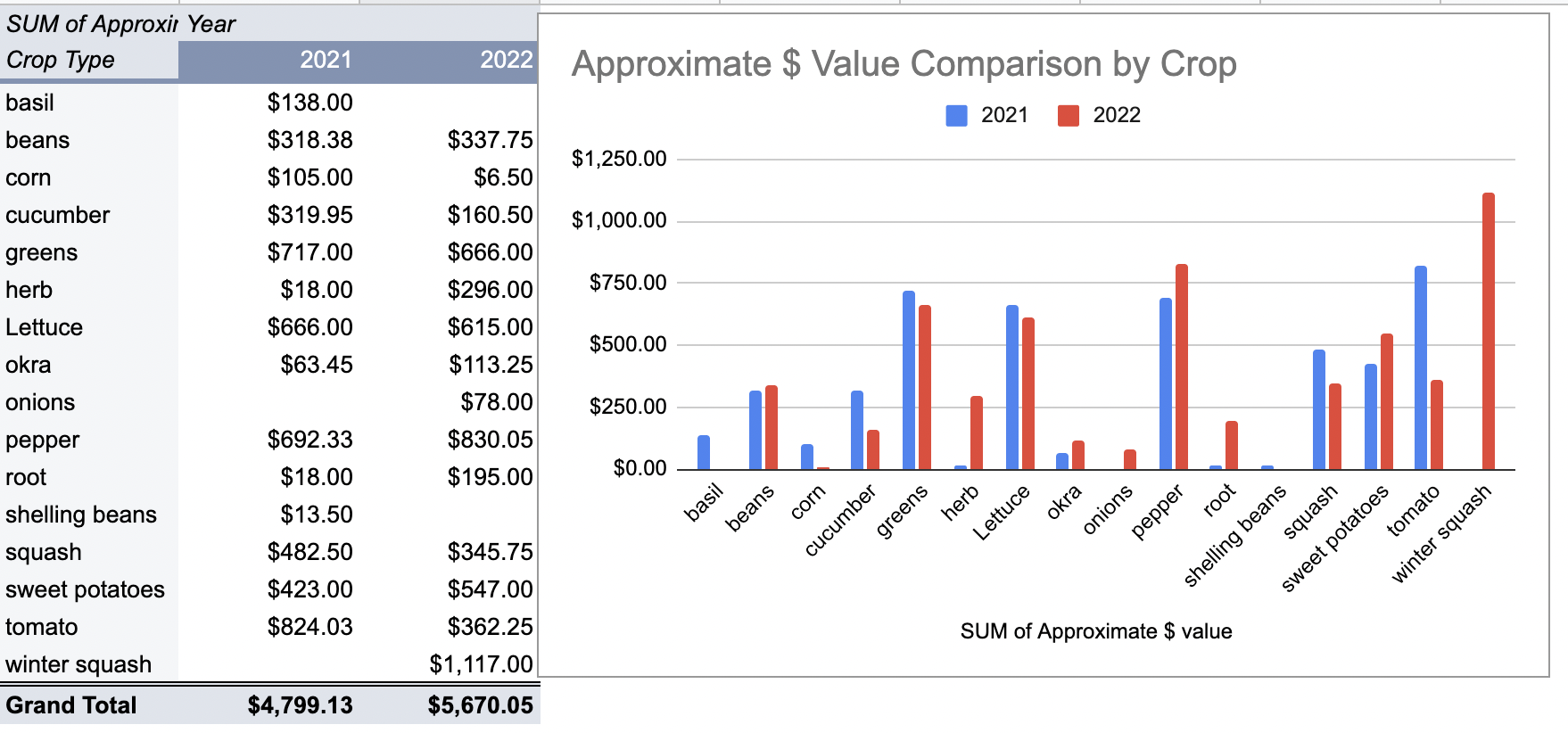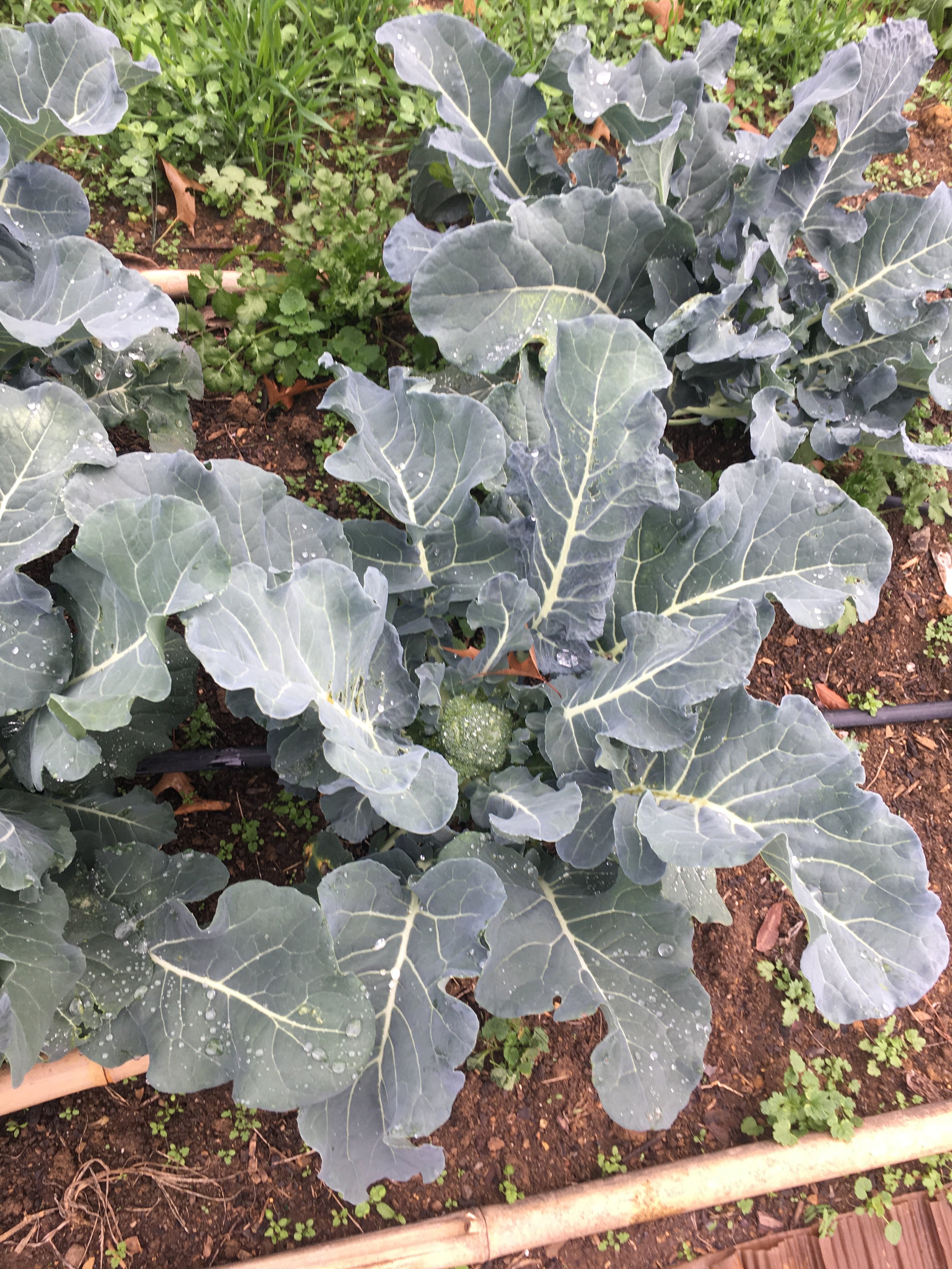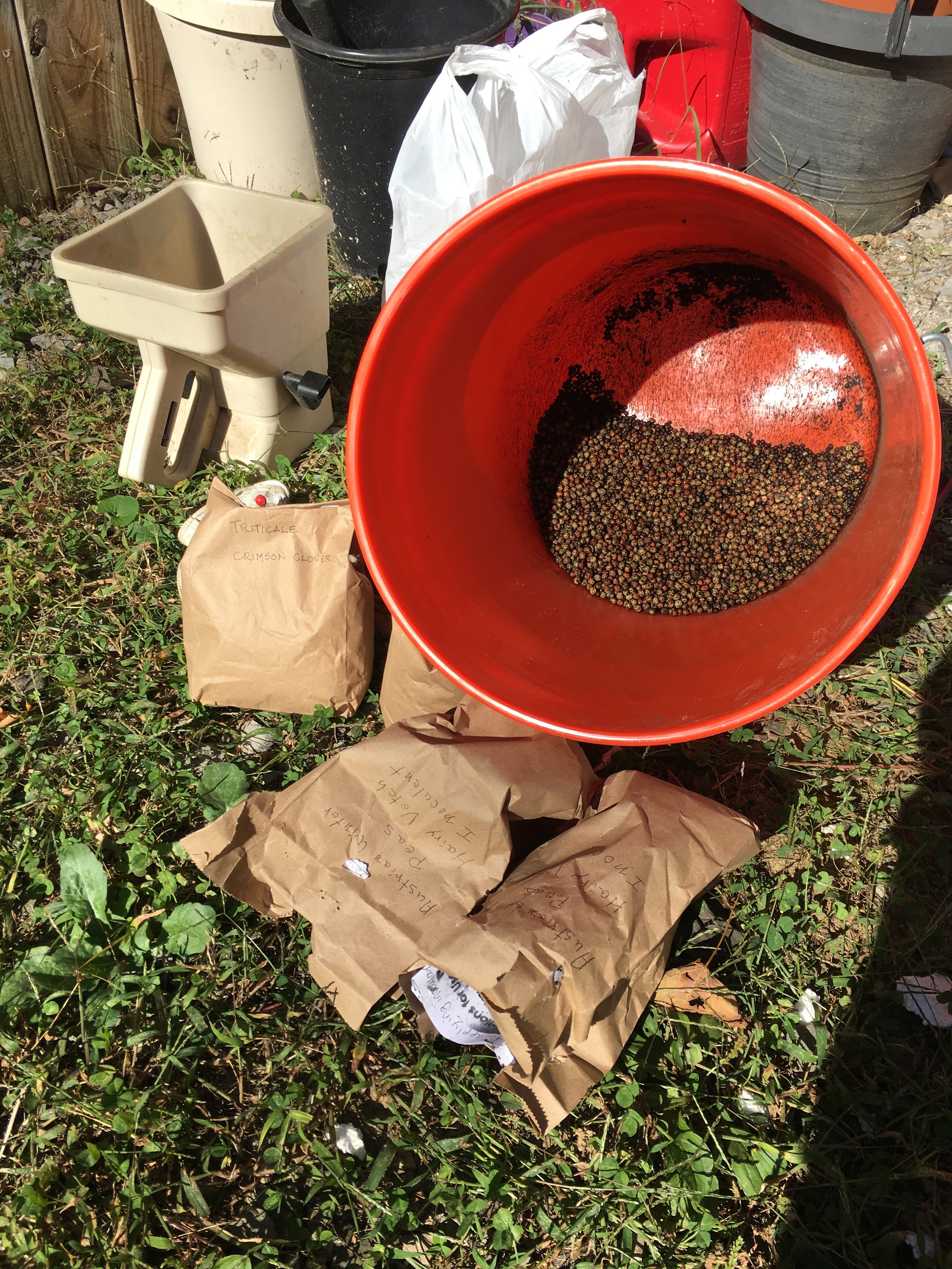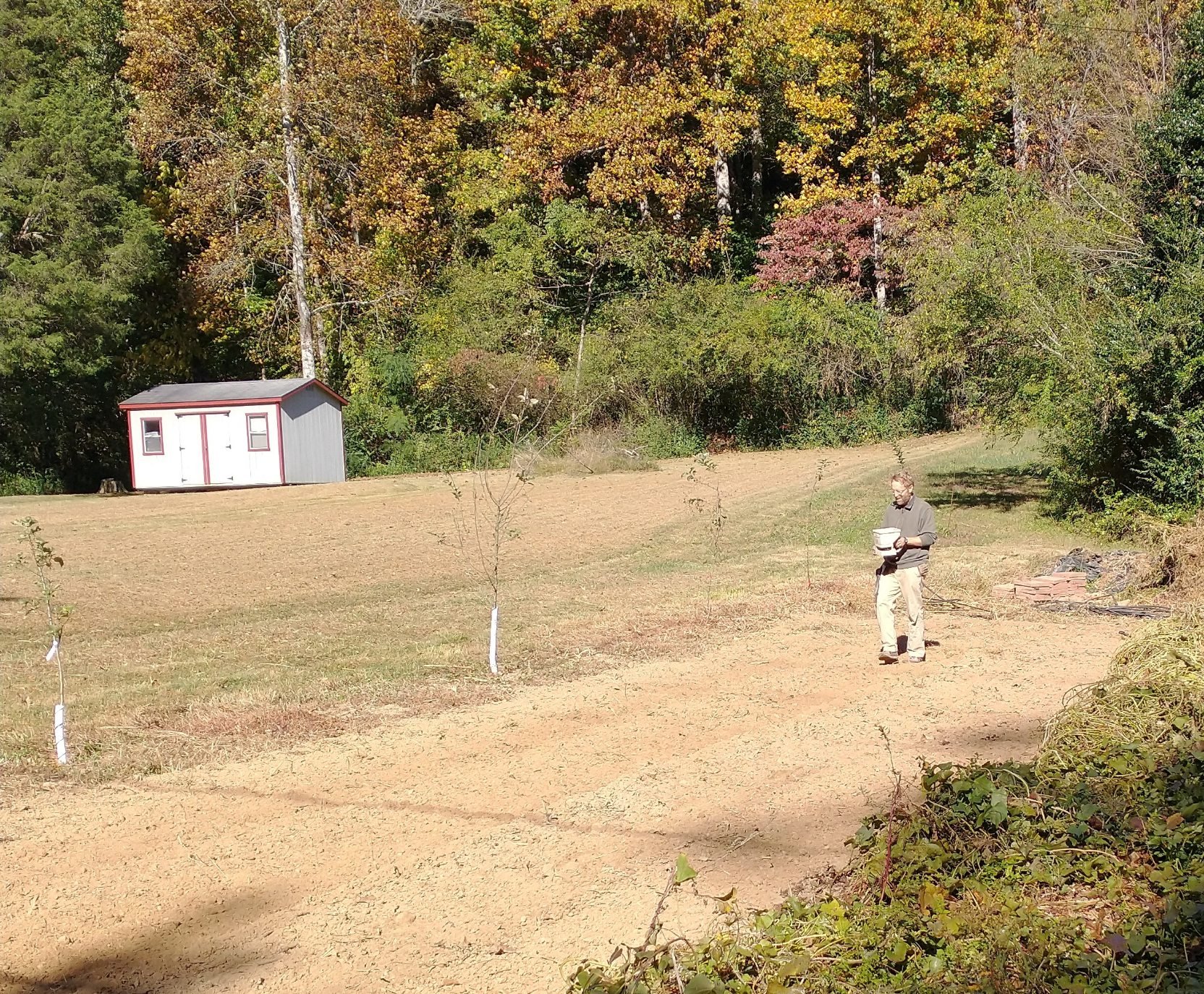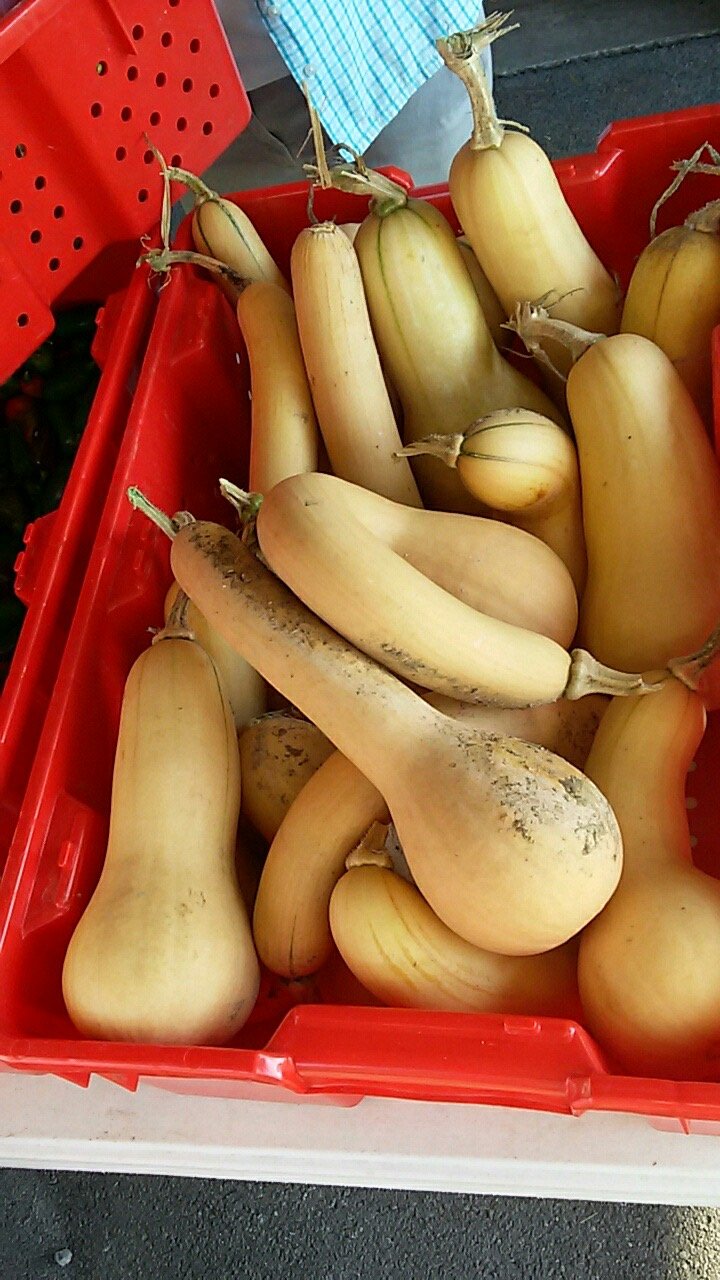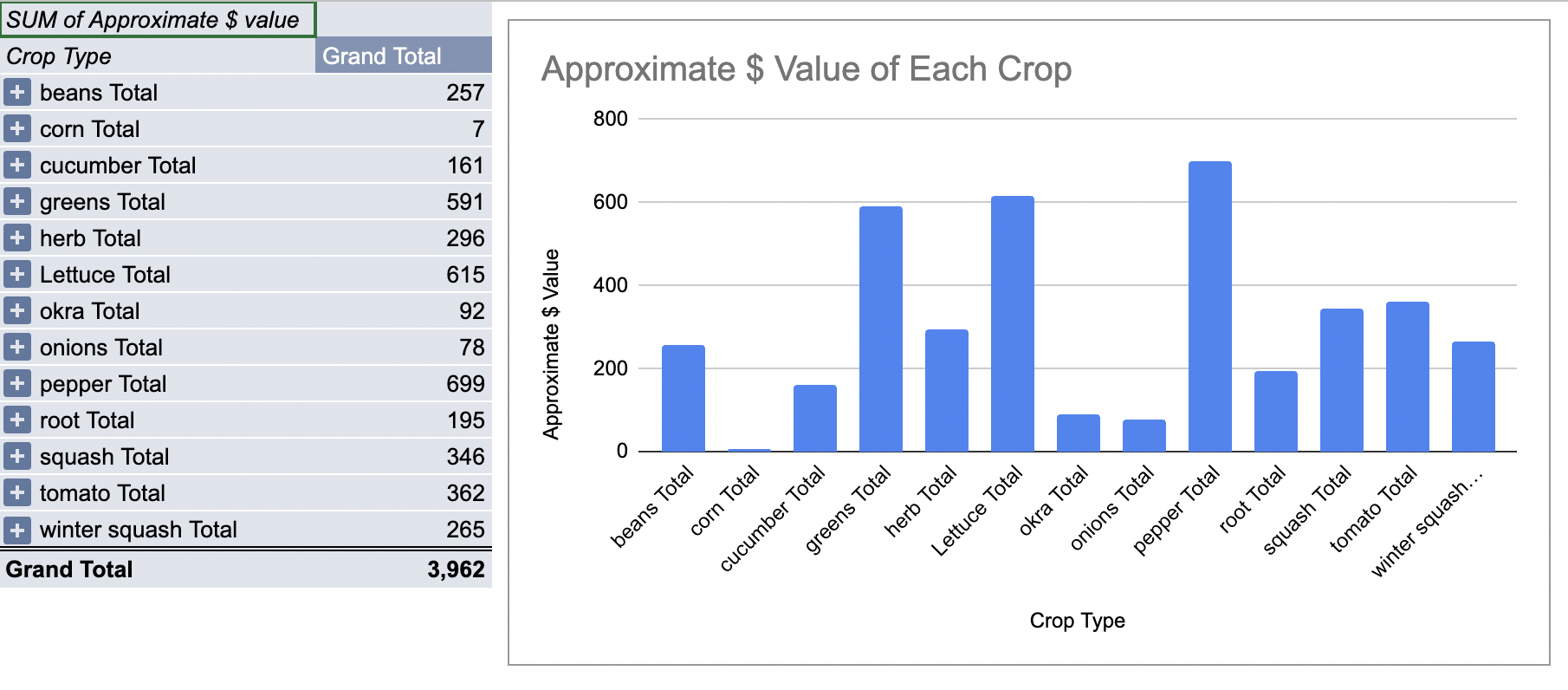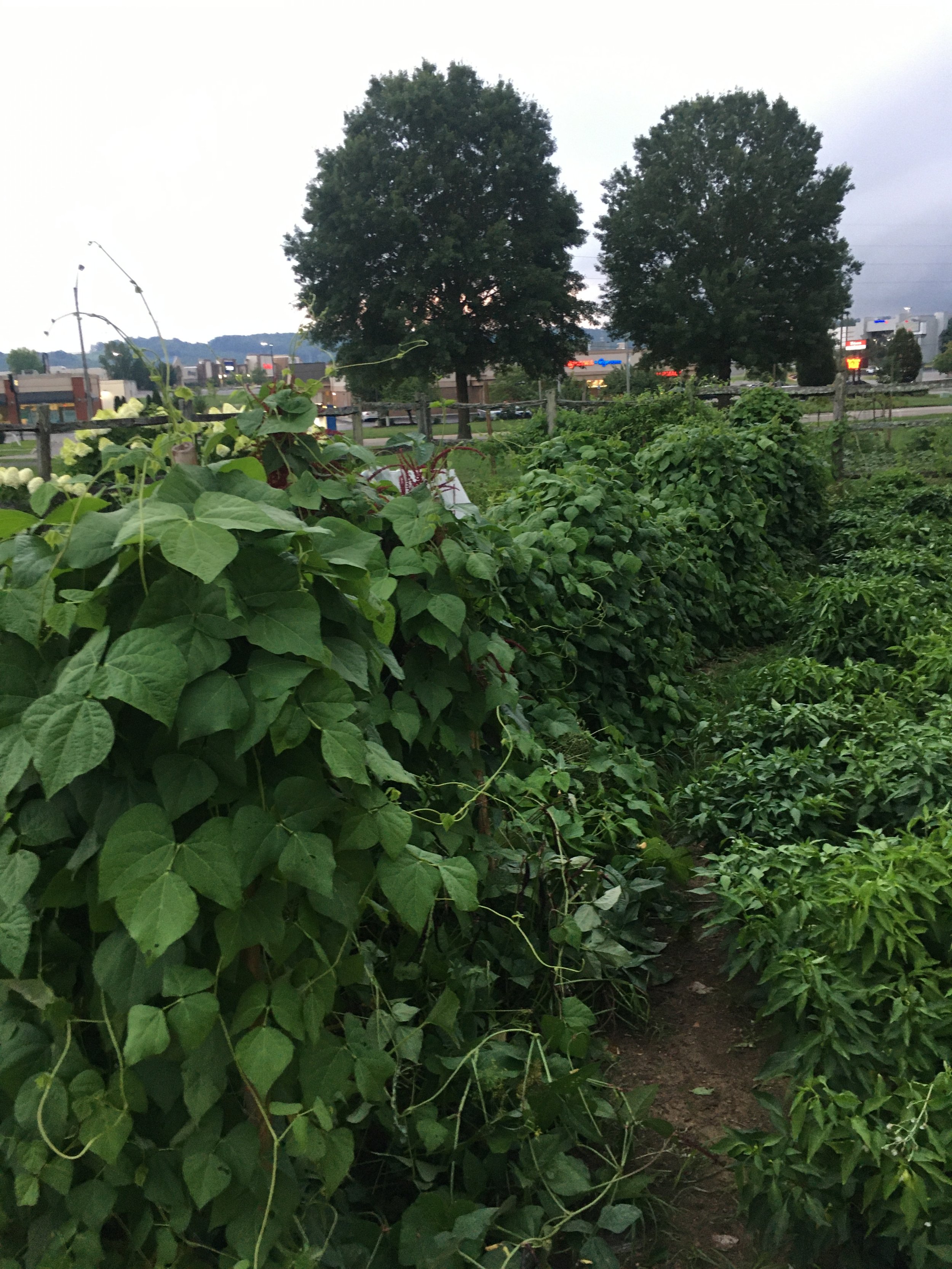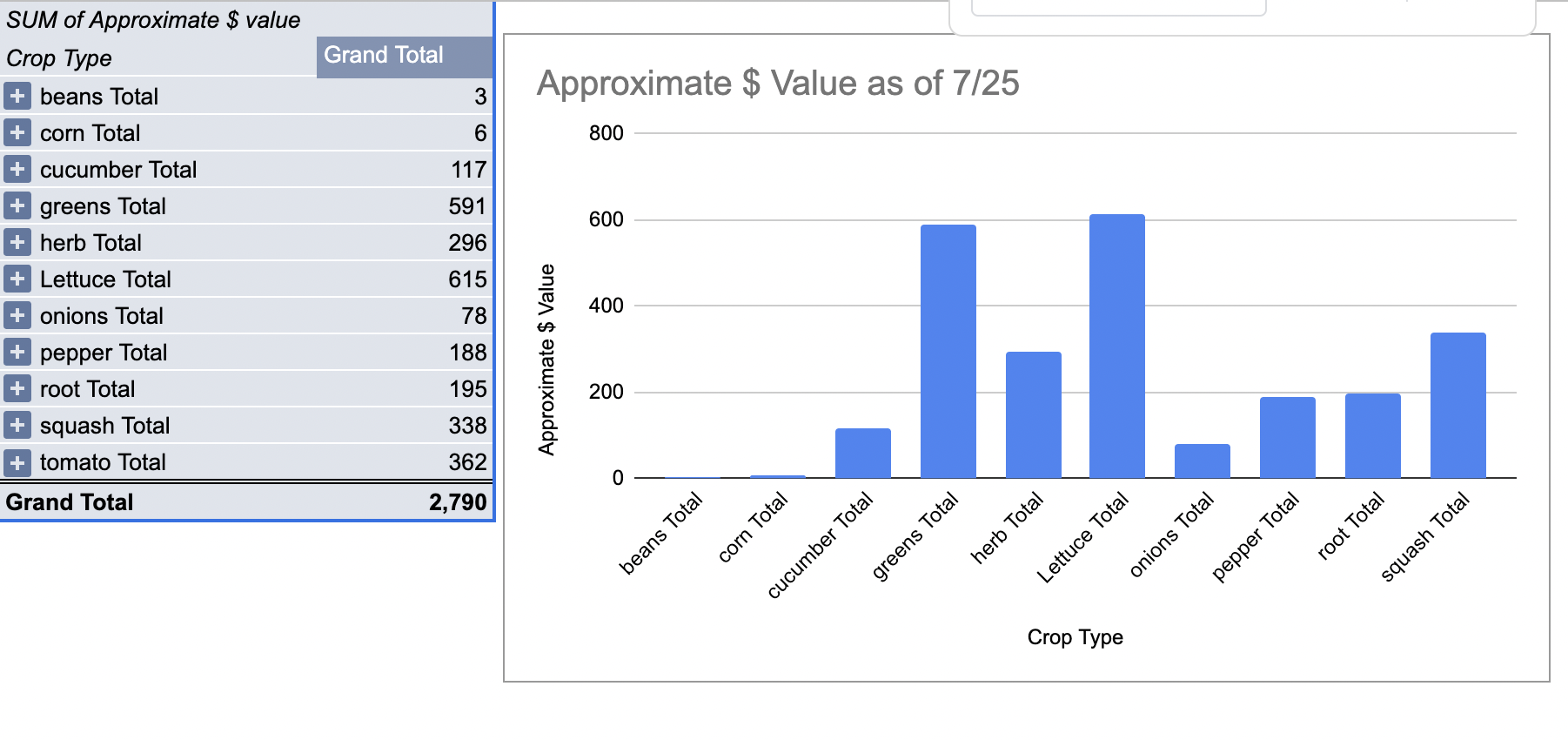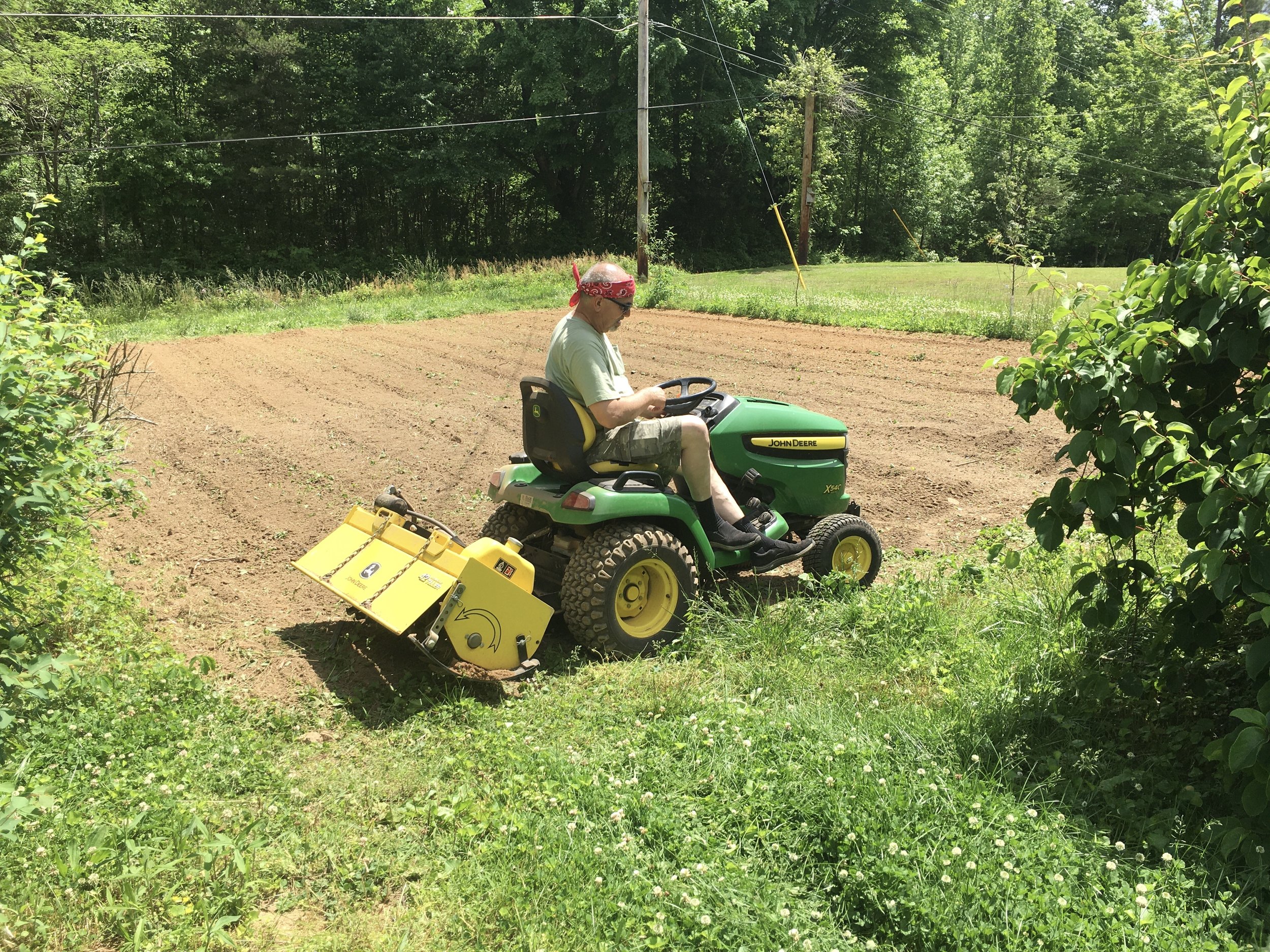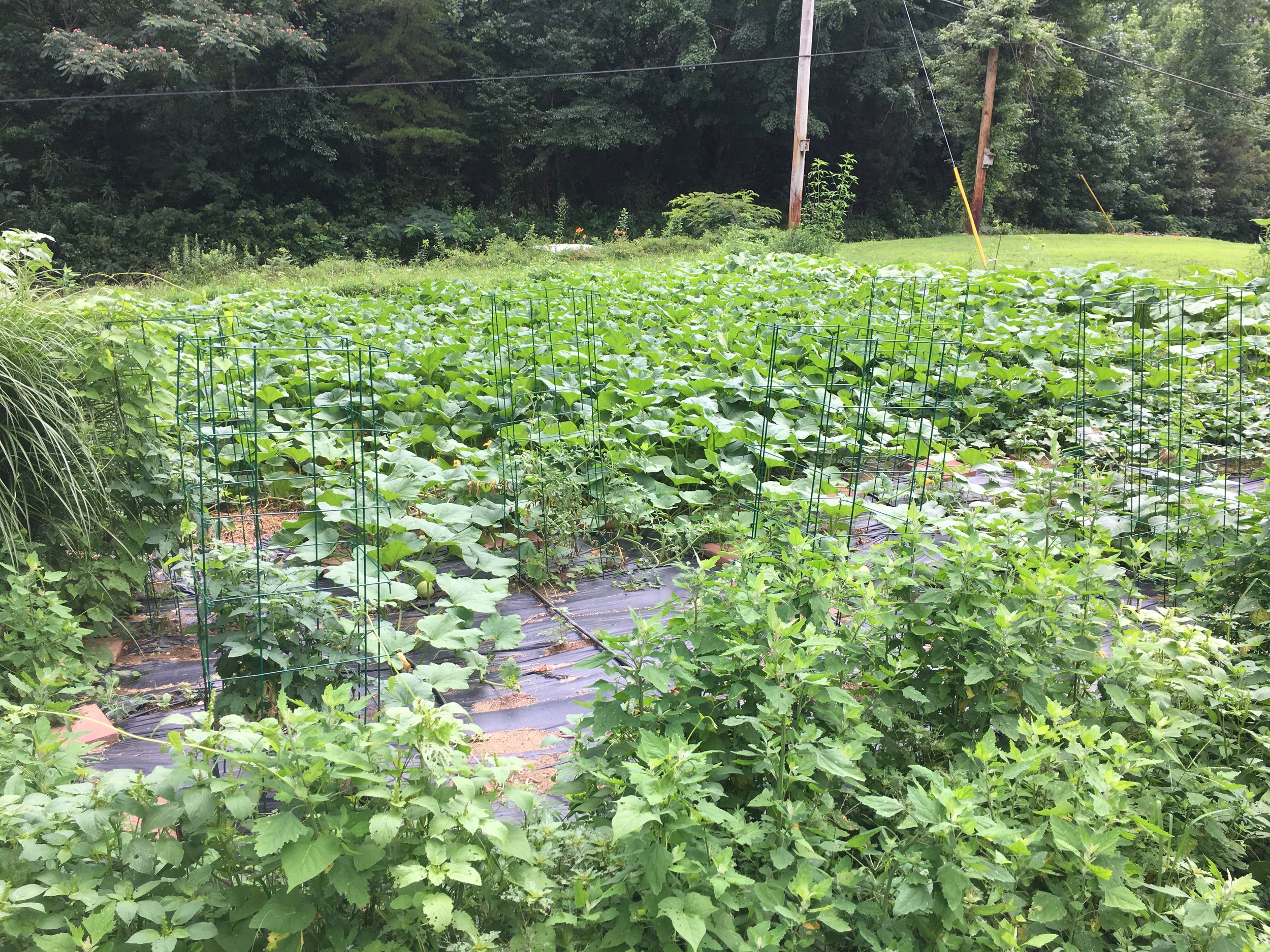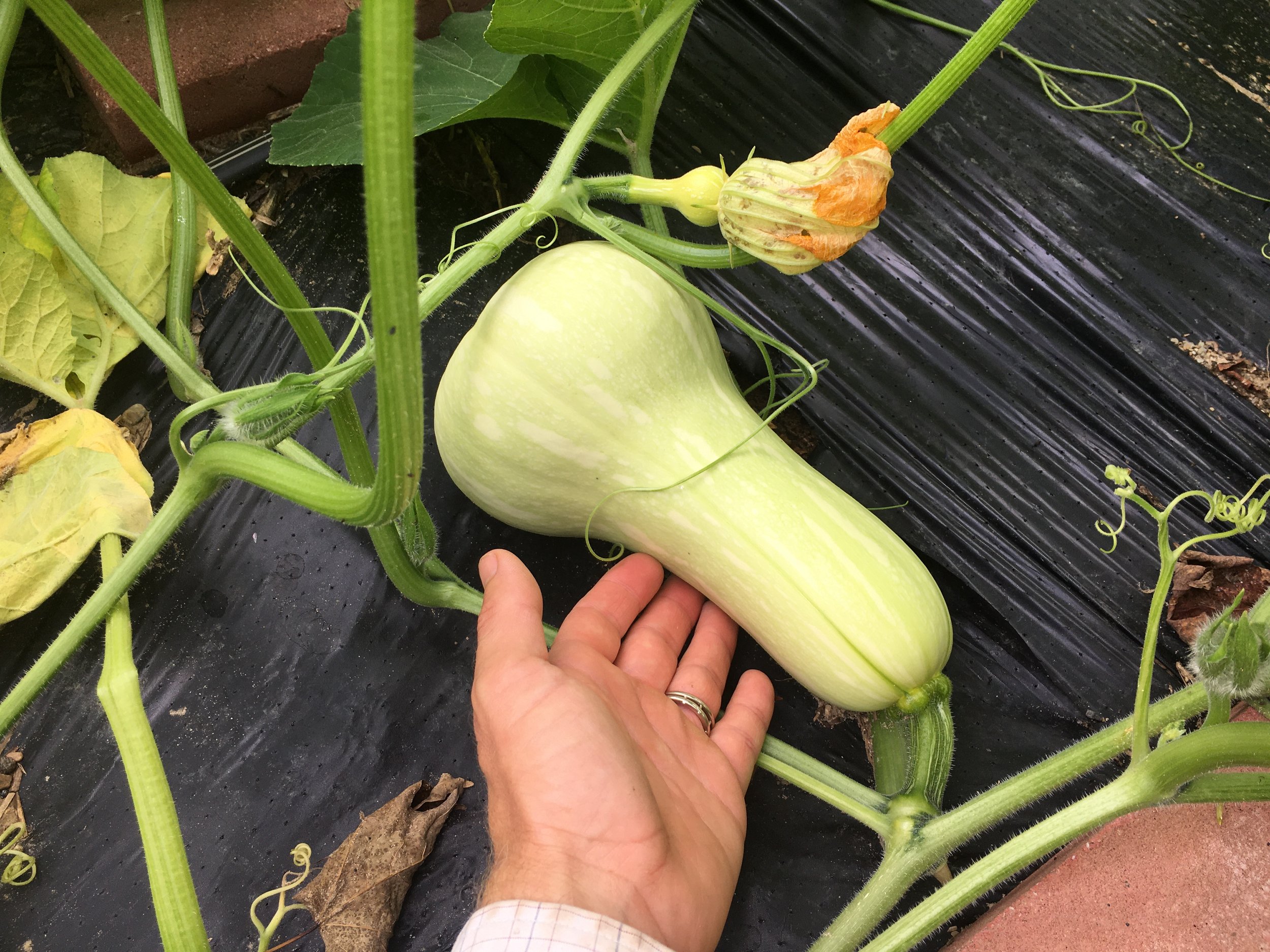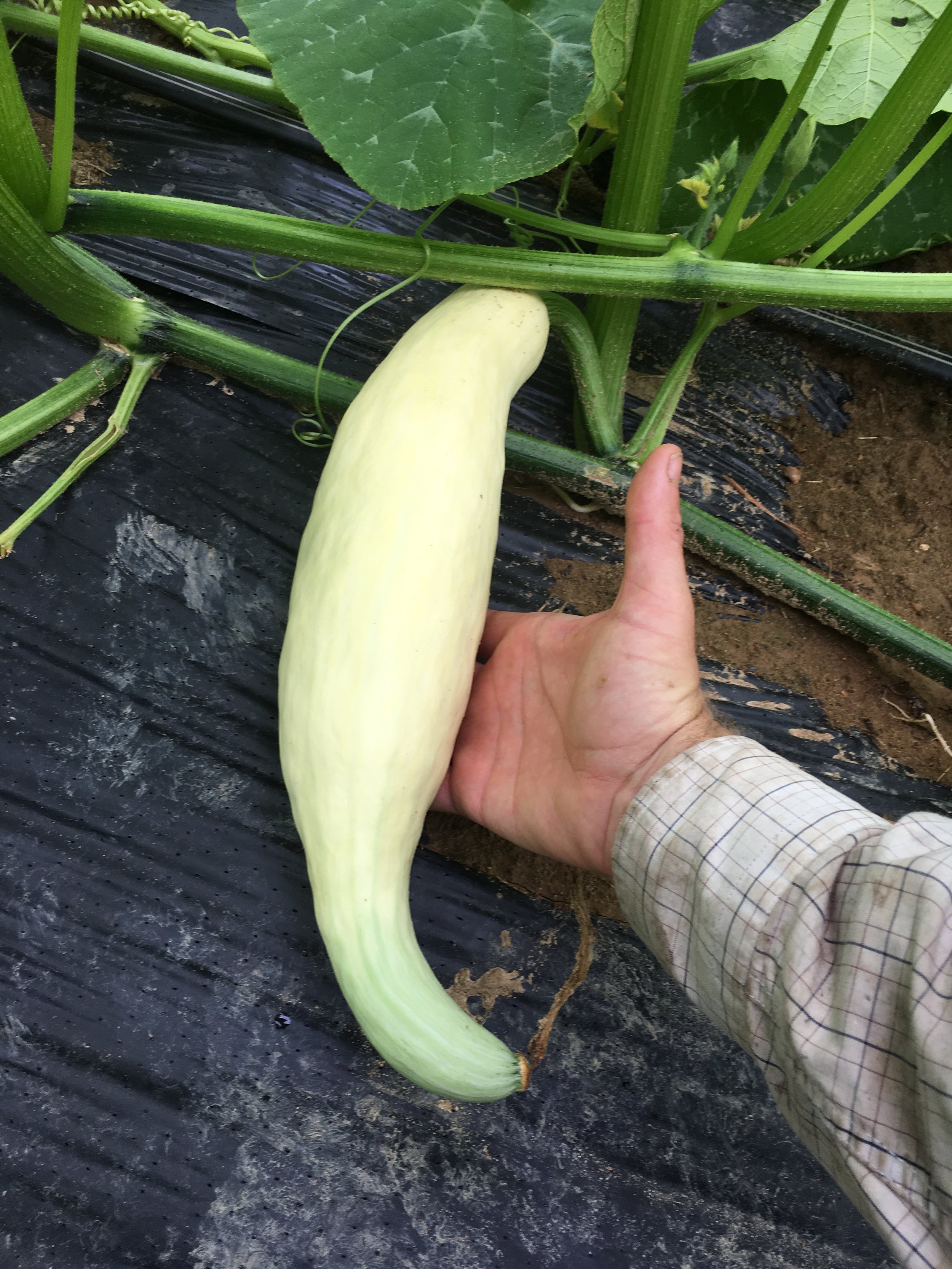Greens! Why didn't we plant more greens?
Next work day: Monday, 11/14, 4pm
Wednesday morning 11/16, 745 or 845 greens harvest for food pantry. Contact Jason if you want to join.
Why didn’t we plant more greens?
The greens growing at St. Mary’s look so nice and healthy. I wish we had a huge crop for our neighbors. So why we didn’t plant more? Well we just have to think back and remember what was happening just a few weeks ago…
We had some serious fish to fry! We had peppers, beans, and okra to harvest. We had weeds growing everywhere. We had major pest problems and areas to clean up. This was a challenging summer for us.
With a little more help during the hard times, we will be able to do more to feed our hungry neighbors.
We have some good ideas for reducing the overall workload so that our efforts can stretch a little further in 2023.
What we plan to implement in 2023
—Three 4’ x 20’ raised beds on the east edge.
—Ground cover on the majority of the garden to reduce weed maintenance and reduce pests.
—Fewer tomato plants, more carefully managed.
—Increased pathway access to make work easier.
—Better irrigation maintenance.
A working diagram of our row cover plan at St. Mary’s garden.
The 2022 greens have the potential to surpass the 2021 production.
Wednesday, 11/9 early morning greens harvest + Monday, 11/7 clean-up
Next work day: Monday, 11/7, 4PM
Wednesday, 11/9, ~745am: Jason S. plans to harvest collards and kale for the pantry.
We plan to move and reorganize cinder blocks. We plan to pull up and store irrigation equipment.
Here’s what’s growing now: broccoli, cauliflower, collards, kale, cilantro.
Broccoli is making heads. You can see cilantro in the background.
We are continuing to delivery sweet potatoes and butternut squash to the food pantry.
194 lbs of sweet potatoes and counting! Time to become an Anderson County Master Gardener
It’s time to register to become a master gardener!
I have noticed that when I make a commitment to my community, I find ways to take positive steps to make the commitment a reality. Gardens serve so many needs in our community and the UT Extension Master Gardening program gives us structure for coordinating our resources. I have gotten invested. I’ve stepped up. I’m finding ways to improve my community through gardening. Please join me!
https://anderson.tennessee.edu/master-gardener-program/
Work day: CORRECTION: Halloween, Monday, 4:00PM.
We made some serious messes and trip hazards in our effort to clean up. Hopefully we can make more progress on clean-up.
It would be nice to add some winter protection to our greens.
We culled some of these. But that’s 194 lbs of sweet potatoes. This was from 2 rows. Chris has three more rows to harvest.
Sweet potatoes come in a $2/pound rather than the normal $3/pound. That’s based on Jason S.’s perception of the farmers’ market prices for sweet potatoes.
Sweet potatoes are coming in at a similar rate as 2021. But Chris planted three more rows this year, so we have a lot more on the way. Also, we had a small harvest at the Isidore and Maria garden that needs to be weighed in. We have lots more sweet potatoes on the way!
Next year with crop totals
It’s deceptive to assume that all of the crops have the same value. Some crops consume more resources in terms of space and time. For example, winter squash look productive, but they required a giant field where little else could grow at the same time.
Likewise, some herbs may not look like a major contributor to the overall total, but the cilantro took up only a small amount of space and we didn’t even plant it! All of the cilantro volunteered this past year where we planted cilantro the previous year.
I have a goal in 2023 to devise methods for tracking the amount of resources that crops consume. This information may help us make more informed decisions about what we might want to grow and how we want to grow it.
Butternut squash to share
As a gardener in the St. Mary’s garden, you may claim some of the harvest. If you are an active part of our gardening effort, please communicate your butternut squash desires to us. We will set some aside for you.
Key totals for 2022, cover crop images
Next Work Day: Monday, 5:30PM.
We will work on removing weeds, relocating materials to get ready for laying down ground cover for 2023.
Thanks for your attention to the St. Mary’s Community garden blog for 2022. I may reduce blog updates for the remainder of 2022. Please keep in touch via email or text. We will work on the following projects throughout the winter:
Installing ground cover
Installing raised beds on east edge
Re-figuring and setting crop rotation based on new layout
Planning spring and summer seedling production
I created a shared spreadsheet for communicating projects and person-hours. Initially I thought it was a great idea, but as I started drafting the sheets, I started to wonder if it was worth it. Let me know what you think.
COMMUNITY GARDEN PROJECTS shared spreadsheet
If you like the spreadsheet and want to contribute a project, feel free to text or email Jason.
Each of the cover crops have emerged at St. Mary’s. We hope for continued growth and a nice stand for 2023. I can see cotyledon for all four crops in this mix all over the garden: triticale, crimson clover, Austrian winter peas, and hairy vetch.
We plan to have a modified bed layout in 2023, so this raised bed may not match up perfectly to the new plan. But that’s ok!
The approximate $ value of 2022 exceeded 2021 despite the tomato set-back. Winter squash leads the way thanks to the addition of the Isidore and Maria garden. We have not yet included the 2022 sweet potatoes in this total.
We harvested 40 lbs more peppers in 2022 than in 2021.
Bean record set last Monday…two pounds more than last 2021! This 2022 pole bean crop behaved dramatically different from the bush beans of 2021. We do not know for sure what caused the later harvest in 2022: change in variety or weather conditions.
Cover crops are planted!
The St. Mary’s and Isidore and Maria gardens help provide fresh produce to hungry neighbors who come to the St. Joseph’s food pantry.
NEWS: The cover crops are planted at St. Mary’s garden and at the Isidore and Maria garden. We only need to harvest sweet potatoes and a few peppers, okra, and beans.
We will start harvesting collards and kale very soon. Unfortunately we did not plant any lettuce for the fall. Probably we did not have any left over seed laying around. Maybe we will get that done next year.
NEXT GROUP WORK TIME: Monday, 5:30PM. This will be a short harvest. We will start clearing out some areas to get ready for a new layout for 2023.
Last week Karen, Matthew, Jason N., and Jason S. did a quick harvest. We had enough time to rake in the cover crop seed. Jason S. has been stopping in at the garden every day to water the crop.
This past Monday, Tom and Jason S. did a quick harvest. We started the cleanup of the front area of the garden.
The approximate $ value is $3/pound for many crops, $3/squash for winter squash, and $3/bunch for greens and lettuce. We do have specific quantity data that we can use to compare crop values from each year. Please get in touch with us if you have curiosities about specific crops from year to year.
Tom tilled the soil at the Isidore and Maria garden. This soil was quite compacted. We will harvest the sweet potatoes soon. After we harvest the sweet potatoes, we will spread a few handfuls of cover crop on that section to avoid a bare spot.
Jason added inoculant to the peas and vetch. He had to moisten the seed to encourage the inoculant to adhere to the seed surface. After a few minutes of drying, he mixed all of the seed together before adding it to the hand spreader in small batches. The hand spreader required some serious wrist strength.
Jason uses a hand crank spreader to spread our cover crop seed onto the Isidore and Maria garden. Tom did a follow-up quick till to make sure that the seed makes contact. We are praying for rain!
What a great and challenging summer it's been!
Next work time: Monday evening ~5:30PM
We will harvest peppers, okra, and beans. We may do some clean-up tasks to get ready for plans that we have for 2023. Speaking of 2023…
Fall Meeting 2022
We had a meeting a couple of weeks ago at Tom’s house. Here is the gist of what we discussed:
We may not grow summer squash next year to see if we can break the squash vine borer cycle for 2024.
We may reorganize our plans to focus on assigning leaders to different garden tasks.
We have already started collecting data to determine the number of “person hours” assigned to various tasks.
We are considering installing an irrigation timer. Some risks include the possibility of leaks in our irrigation hook-up.
In order to reduce weeding tasks we plan to order some sort of high durability ground covering such as “Lumite”. We may receive some samples to test it out soon.
Varieties to grow: Beans (pole varieties), tomatoes (2 or three varieties, not too big, not too small), peppers (bell, jalapeno, sweet banana, lunchbox), okra, lettuce (romaine, other), kale, collards, cilantro/parsley, cucumber and probably some more.
Cover crop plan at SMOR: We planted mostly triticale, austrian winter pea, hairy vetch, and crimson clover on open beds. Underneath the okra and peppers, we planted some older seed (cereal rye or oats, vetch, and winter peas) that may get established. We plan to allow these crops to get as mature as possible in Spring before terminating them and then planting the summer crops into the residue.
Cover crop plan at Isidore and Maria garden: Sow triticale, pea, vetch, and clover by mid-October. We plan to till the crop in with a quick shallow pass. If we do it this week, we might get rain on Thursday. Otherwise we are wondering if our drip line will be enough to irrigate this cover crop. We will see….
We plan to have a few smaller meetings to celebrate successes and hash out details on some items that were not discussed.
A new layout. In this layout we will install three permanent raised beds on the east edge of the garden. These will not get washed out in our June storms. The remaining 7 beds are more narrow. After a couple of years of intense spacing in wider beds, we recognize that we may benefit from wider spacings to make weeding and harvesting easier. Also we hope that this format will allow volunteers to move around a little bit easier during the main season when things get crowded. Note the the far west edge (on the right hand side) will be reserved for perennial crops and other fun things that growers want to try.
Last week we harvested all of the butternut and candy roaster squash from the Isidore and Maria garden. We will store these crops for several weeks and hand them out at the pantry over time. We will start harvesting sweet potatoes over the next few weeks.
Butternut $3 each
Candy roaster $5 each
Oliver near a massive butternut and candy roaster squash harvest at the Isidore and Maria garden.
Tom noticed that I was taking this picture!
Cover Crop Plan + Next work day
Next Work Day: On this coming Monday, 10/3, I hope we can start a little earlier especially since it’s getting dark early. Feel free to stop in any time to help.
This week, depending on the timing and how many volunteers show up, we will split up and do a harvest and get the soil ready for cover crop. Also, the Isidore and Maria garden may need a work crew. We will see how it goes.
Harvest Totals:
We are still shy of the 2021 record of $2800. We might break that record with peppers, butternut, and sweet potatoes.
I just want to brag on our volunteers for continually breaking the pepper record set in 2021. So I plan to keep showing this graph until we pull up the pepper plants.
Cover Crop
This coming week at St. Mary’s garden and at the Isidore and Maria garden we will prepare the soil for planting the overwintering cover crop.
Background: William Gwin from the Oak Ridge Public library and I researched and calculated an appropriate cover crop seed mix based on the approximate area of the Isidore and Maria gardens, First Presbyterian gardens, and the St. Mary’s garden. The bulk purchase helps us reduce shipping costs and increase opportunities for other gardens in Oak Ridge.
Volunteers at the Oak Ridge Public library mixed and formed several packs that will cover 1000 ft^2 each.
We will share the packs with each of the community gardens based on need. Hopefully the community gardens can help compensate for the cost of the seed.
Planting: We hope to spread and water this seed as soon as possible with our goal of getting it in the ground by mid October. If the crop goes in too late, it will not be well established before winter.
Goals: This mix is designed to “overwinter”. The components are hairy vetch (legume), Austrian winter pea (legume), crimson clover (legume), and triticale (grassy biomass). With adequate water, plants will germinate, survive our relatively mild winter and grow fast in the Spring.
The longer we can let them grow in the Spring, the more benefit we should attain in the form of micronutrient retention, increased nitrogen and increased biomass. Nutrients and nitrogen help the next crop grow well. Biomass provides food and structure for beneficial soil bacteria and fungi.
Termination in Spring: We can handle the termination in several ways depending on our needs at each garden. For example, at the Isidore and Maria garden we will mow and then till 4-6 weeks before planting our long season winter squash and sweet potatoes in mid-June.
At St. Mary’s we will likely mow these crops at different times depending on what we will plant in each bed. At St. Mary’s we usually allow the cover crop to become a mulch on the surface that we plant through when our seedlings are ready.
What do these crops do for us? With proper legume inoculation (see below) we hope that these cover crops will supply most of the nitrogen that we need to start the season. But depending on our soil tests we may need to supplement phosphorus, potassium or trace minerals. If these crops go back into our growing areas, they will help retain the P, K and trace minerals from the previous season, but they will not increase those minerals. A soil test before Spring will help us know our P, K, and trace mineral needs. Some crops may benefit from more nitrogen later in the season after the cover crop benefit is depleted. The biomass of these crops will improve soil texture and provide fuel to stimulate beneficial fungal and microbiological soil activity.
I have hope that this plan works well. Special thanks to William Gwin at the Oak Ridge public library seed library for getting this plan started.
Inoculating legumes
At least 79% of the air around us is nitrogen gas (N2). We inhale it, but we exhale it without using it. Animals and plants need nitrogen to grow. It is part of our protein, DNA, RNA, and many other parts of all living things. It’s funny to me that we are surrounded by necessary nitrogen in the air, but we can hardly use any of that nitrogen for our body.
It turns out that legumes can form a symbiotic relationship with microbes in their root zone. If those microbes “infect” and colonize in the roots of legumes, those plants will “fix” nitrogen from the air and make it available to the plant. If we growers make sure that those microbes are present, if we grow the legumes at the correct time, and if we terminate the plants at the proper time, we can make sure our soil and organic residue in the soil generate nitrogen in a form that plants can use for growth.
So we ordered some inoculant and we have a plan for inoculating the legumes in our mix.
Here’s an article from the University of Minnesota that explains legume inoculation with better pictures and more technical detail: University of Minnesota Extension
The butternut squash keep coming in from Isidore and Maria garden every week! Special thanks to Walter Dykas for keeping the flow going.
Garden meeting + We broke the pepper record and they’re still coming!
Butternut squashes from the Isidore and Maria garden keep on coming!
The mission of the St. Mary’s Community garden is to feed the hungry by growing fresh vegetables for our neighbors who come to the St. Joseph’s food pantry. This year we added the Isidore and Maria garden on Dutch Valley Road where we produce long season winter squash and some sweet potatoes in order to serve our neighbors longer into the winter.
We receive financial support from gardeners, parishioners at St. Mary’s Church, the Pope Francis Charitable Fund, the Council of Catholic Women, and the St. Vincent de Paul Society. Our main contributors are volunteers who work tirelessly throughout the year to plan, plant, weed, cultivate, and harvest these crops.
Sometimes the volunteers get to take a little of the food home.
Fall Planning Meeting 2022: Saturday, 9/24/2022, 1-3PM at Tom Thornton’s house. Please contact Jason or Tom or check the group email for his address. We have a very full agenda and every agenda item is connected to our mission to feed our hungry neighbors.
Next work day: Monday, 6PM. It should be nice weather. We will harvest, continue weeding, and prepare soil for cover crop planting.
Last Monday we had 9 volunteers who worked hard to harvest and weed. We are almost ready for our cover crop. Hopefully we can plant that cover crop after we have clear plan for 2023 after our meeting.
We had difficulties and successes this year:
Difficulties: Reduced squash production due to vine borers and limited space, limited corn and tomato production due to pests.
Successes: Record pepper production! First ever winter squash production at the Isidore and Maria garden. Record lettuce production.
My graph shows the pattern of the 2022 harvest compared to the 2021 harvest. The table on the left shows the total pounds harvested across the season.
I have not quite figured out the best way to show this data, but this gives a general picture of the pepper success this year compared to last year.
We just broke the 2021 pepper record and we still have some weeks left to harvest more peppers.
Spicy news!
Next work day: Monday, 6PM. We will harvest, weed, and spread cardboard. We are getting ready to sow the over-winter cover crop. I’ll share more news about our cover crop plan next week. Please bring cardboard if you happen to have any or if you know where to find some.
We had an excellent crew show up on Monday evening. Please come out and help even for a little while. The weather is perfect!
Our Fall Meeting is set for 9/24, 1-3PM at Tom’s House: Please check email for more information about the location. Please contact me if you have anything else to add to the agenda. Here’s a link to the agenda in progress.
We have one chili pepper plant that delivered these red hot chili peppers to the pantry. That’s the spicy news for this week!
Peppers finally surpassed the Spring lettuce in approximate value.
This week we harvested and delivered $200 worth of butternut, peppers, green beans, and okra.
Butternut squash will increase every week until the Isidore and Maria garden runs out. Then we will have some sweet potatoes from the St. Mary’s garden and the Isidore and Maria garden. Fall greens will start up in a few weeks at the St. Mary’s garden.
In other pepper news, we are just 20 pounds away from breaking the pepper record that we set in 2021.
The above chart represents total pounds of peppers harvested each week in 2021 and 2022 (so far).
We owe gratitude to St. Mary’s Church and School for allowing the garden to store our harvest in the church coolers. I hope that we are not being too much of an imposition. This is what our red bins look like in the cooler. They stay stored cold until we can deliver the harvest to the pantry on Wednesday morning.
An excellent Labor Day harvest for our neighbors!
A committed group of volunteers made the harvest happen on Labor Day. Thank you for taking care of our neighbors. The harvest on Monday totaled approximately $260 of produce. We have exceeded $3500 for this season so far. Peppers are about to overtake lettuce in total value. I look forward to sharing the pepper comparison from 2021 to 2022. For the record, we harvested peppers until November last year. We can expect a lot more peppers for our neighbors.
Work day: Monday evening, 6PM
Announcement: Fall Planning Meeting Saturday, 9/24, 1-3 PM, Location: Tom’s House! Please check email or contact Jason for more information about how to find Tom’s house.
Does anyone want to volunteer a venue?
Here’s a link to the agenda for the St. Mary’s Fall Garden Meeting 2022.
Please email me if you want to add something to the agenda.
New Leadership Notice #4
We are looking for a fresh take on managing the St. Mary’s garden. Please get in touch if you are interested.
This is the butternut harvest for next week. Walter harvested 20 more squash this morning. At this rate we could supply butternut squash to the pantry for several weeks.
A quick shot of the harvest on Labor day. Thanks again to those who used their valuable Labor day break to harvest for our neighbors.
Pepper record and first delivery from the Isidore and Maria gardens.
We are growing fresh food for our neighbors for distribution at the St. Joseph’s food pantry in response to Jesus’s command to love our neighbors.
Our pepper harvest last week was a record for 2021 and 2022, 37 lbs.
We delivered our first butternut squashes from the Isidore and Maria gardens to the St. Joseph’s food pantry this week, 15 squashes. You can read more about the Isidore and Maria garden in our previous post.
Next Work Day, Labor Day, 9/5/2022 ~6PM
Most people don’t work on Labor day, but the food is still coming and our neighbors still need it! Please consider helping in the garden. Jason plans to get there as early as possible. There is a community concert happening at Bissell Park from 7-8:30PM. Maybe we can finish early if we start working early.
To do:
harvest okra, peppers, green beans
weed beds and pathways
Weed the western edge of the garden, remove weeds into Jason’s truck for composting
Be careful if you decide to weed beds #1 and #2. We have very small collards and kale coming up in those beds. Make sure that you know the difference between the weeds and the food.
This week we had a record for the year of green beans of 20.75 lbs. By winter we expect the winter squash value to rival the spring lettuce value. Then again, we expect to start harvesting greens again. It is possible that greens will be our most valuable crop of 2022. Stay tuned to find out!
Walter Dykas harvested and delivered 15 squashes from the Isidore and Maria garden. He estimates at least 200 squashes resting peacefully in the field. We will attempt to deliver squashed each week until we run out. This was the first delivery from the Isidore and Maria garden!
Fall Meeting Planning Notice #3
We hope to have a group meeting at a gardener’s house on Saturday, 9/17 or 9/24. We are still waiting to hear back from a couple of gardeners.
Here’s a link to the agenda for the St. Mary’s Fall Garden Meeting 2022.
Please email me if you want to add something to the agenda.
New Leadership Notice #3
If you want to try your hand at managing a production style community garden, the St. Mary’s garden and the Isidore and Maria gardens will give you valuable experience. If you are interested in this leadership opportunity, please let Jason know so that we can add your name to the agenda.
Do not be discouraged, fall greens cotyledons are present
Next workday: Monday 8/29, ~6pm
Labor day, Monday 9/5, ~6pm…I know that everyone will be home from their travels, right?
This is a great time of year to work at St. Mary’s garden. The weather is fine in the evening and we need a lot of help.
To do:
Harvest, measure, store the okra, beans, peppers
Weed the western edge of the garden, remove weeds into Jason’s truck for composting
Continue hand weeding among the beans, peppers, and okra
Be careful if you weed bed #2 where Tom planted kale and collard seed. Look carefully for the fall collard and kale cotyledons.
Please note: If we weed the garden well before the weeds go to seed, we may have a better time in 2023. Does anyone remember the out-of-control morning glory of 2021? It’s possible that our diligent weeding of morning glory in the late summer last year helped reduce the morning glory this year.
Do Not Be Discouraged: The tomato production rate in 2022 was outpacing 2021!
Thank you to those volunteers who helped harvest our tomatoes in July. We had to stop those tomatoes early for several reasons. It was sad to see so many tomatoes go to waste. But please do not be discouraged. Before we unearthed the vines, those romas were outpacing our 2021 tomato harvest!
We will learn from 2022 and do even better in 2023.
So Jason finally figured out a simple way to compare the tomato harvest from 2021 to 2022. The harvest rate of our 2022 tomato crop was higher than 2021!
Just two of us harvested $135 worth of produce on Tuesday night. Our neighbors at the St. Joseph’s food pantry took everything except for a handful of jalapeño peppers that will become hot sauce in the Schmidt household.
Fall Meeting Planning Notice #2
Jason and Walter have started compiling agenda items to discuss at our end-of-summer / fall meeting. We hope to have a group meeting at a gardener’s house in the coming weeks. Please look for a doodle poll in email. We will choose the dates where growers are most likely to attend.
Here’s a link to the St. Mary’s Fall Garden Meeting 2022.
Please email me if you want to add something to the agenda.
New Leadership Notice #2
Jason has some good ideas for community gardening and native plant gardening in Oak Ridge for 2023. It’s time for new leadership at St. Mary’s for 2023. If you are interested in helping organize the St. Mary’s garden, please let Jason know so that we can add your name to the agenda.
Get ready for the winter squash from the Isidore and Maria garden on Dutch Valley Road! Last week these butternut squash were not yet ready. By next week it will be time for us to start harvesting and delivering to the pantry. Kathy thinks we have at least 100 squash. Jason thinks it’s closer to 200. Wait until you see the candy roasters!
Finding a leader, independent work ideas, planning our meeting, winter squash
Update: TUESDAY, 8/23/2022 ~6pm
We switch our regular Monday workday to Tuesday in order to celebrate the St. Mary’s Church Founder’s Day.
To do: Harvest, measure, store the okra, beans, peppers
Weed the southern edge of the garden, remove weeds into Jason’s truck for composting
Continue hand weeding among the beans, peppers, and okra
Do not weed bed #2 where Tom planted kale and collard seed.
Independent work
Special thanks to Tom Thornton for planting kale and collard seed in bed #2 where the tomatoes used to be. We anticipate a lot of fall and winter greens. We have supplies for covering these beds for some season extension. Last year we harvested these greens that survived into the Spring. Maybe we will do that again.
Weeding: If you want to work independently we need help with weeds all of the time. If you weed lots of stuff, make distinct small piles that we can scoop out on the next work day.
Do not weed in bed #2 where Tom planted kale and collard seed.
Harvesting: We need help harvesting okra daily. Some of it is getting over grown. If you harvest okra (or any of our peppers or green beans), please refrigerate and deliver to the food pantry on Wednesday mornings.
Pay yourself: Feel free to pay yourself with some produce, flowers, and herbs. Just make sure to record the entire harvest for our records. Your pay is on the honor system.
If you have a large quantity of fresh produce to deliver and you do not have refrigerator space, please contact Jason and we can make plans.
Here are two special independent projects:
Walter Dykas worked hard to construct a building supply storage area. This picture is one iteration. It’s been re-positioned and stabilized and loaded up since our most recent work day.
Chris Johnson manages this robust sweet potato patch located outside the fence on the south side of the garden. Last year this patch provided many pounds of sweet potatoes. It’s shaping up to deliver large quantities this Fall also.
Fall Meeting Planning
Jason has started compiling agenda items to discuss at our end-of-summer / fall meeting. We hope to have a group meeting at a gardener’s house in the coming weeks. Please look for a doodle poll in email. We will choose the dates where growers are most likely to attend.
Here’s a link to the St. Mary’s Fall Garden Meeting 2022.
If you want to see something on this agenda, please email.
New Leadership
It’s been a good couple of years. It’s time for new leadership for 2023. If you are interested in helping organize the garden, please let Jason know so that we can add your name to the agenda.
We have almost hit the $3000 mark for this season!
Winter squashes are coming!
The Isidore and Maria garden on Dutch Valley road has an incredible quantity of butternut and candy roaster squash. They are maturing in the field. Get ready for a massive delivery!
I have a great picture of a few beautiful butternut squash from the Isidore and Maria garden (the website will not load the picture just yet. I will try to add it later).
First draft of lessons learned for 2022...
This is a good year for learning! We did have a decent harvest of cucumbers, squash, and peppers this week even though we decided to take out the crop of tomatoes. I posted the harvest totals at the very bottom of this message.
I am learning what it means to be a good steward of our soil. And this supports our mission to get fresh, nutritious vegetables to our neighbors at the St. Joseph’s food pantry.
The ideas that we have for 2023:
Grow at least two or three varieties of tomatoes.
24” spacing was too close for double rows. We may be able to do 24” spacing on a single row.
If we go for a single row, we might go ahead and use the old cages rather than the Florida weave.
We may incorporate ground cover for weed management. We are discussing whether we should use ground cover in the rows or in the pathways. This decision will be deferred to a future planning meeting.
Very seriously discuss taking a year off of summer squash to see if we can reduce the borers.
Gardeners seem to like the kana hoe. Maybe we can order a few more of those in different shapes and sizes.
Get ready for season extension supplies.
Get ready cover crop seed.
Do all composting and crop and weed debris management off site. Keep the site more tidy.
It’s time to test the soil in several places to see what’s going on with our nutrients.
Upcoming work day tasks for Monday, 8/8/22, ~6PM:
Continue weeding and clean-up
Decide what to plant in the vacant tomato bed: fall greens or cover crop.
Wherever we plant the fall greens, we need to try out Tom’s row cover supplies for season extension. We may need to order additional supplies.
Before Monday: It might be hard to tell in the picture. The trellis did not support the vines as well as I hoped. The tomatoes fell to the ground. Many of them rotted especially after heavy rains. This resulted in a lot of damaged tomatoes. The mess was so bad that we decided it would be better to remove the plants.
We had a good crew and favorable weather on Monday, so we removed the tomatoes. Jason is steadily incorporating the vines and tomatoes into his compost piles at home. We also removed summer squash vines that had damage due to squash vine borers.
Tomatoes from 2021 compared to 2022: I promise that I will get better at presenting this data someday.
The harvest for this week was about $86 worth of produce of peppers, squash, and cucumbers. We should exceed $3000 in the next few weeks especially if the beans start to produce. We will get a boost of production when we get the fall greens to come along. More production means we get more nutritious food to our neighbors.
Let's clean up and re-group a little
We will likely pause our produce delivery to the pantry this coming week.
The work party on Monday evening ~6PM will involve cleaning up the garden. We will remove damaged and unhealthy plants. We will try to clean up our piles of organic matter to make the garden more accessible. We will have a momentary lapse in produce delivery to the pantry until we can catch up and clean up the garden a little. We will make the call on Monday night depending on how much we accomplish.
The tomato trellis did not hold up to our laden vines. As a result the vines sprawled on the ground. This is not a good situation for tomatoes. We will do better next year. We have lots of ideas for how to improve. We were able to harvest more than 120 lbs of tomatoes so far this year.
Meanwhile the bean vines are super huge and overgrown with almost no beans. Out of this mess of vines we harvested only 1 pound of beans.
Our produce values are based on farmers’ market prices. Examples: Herb bunches $2/bunch. Beet bunches cost $3. Tomatoes and peppers go for $3/lb. Please reach out to Jason if you would like more information about the produce data.
Vine Glory: Vice or Virtue?
The St. Mary’s garden pulls together community volunteers and the Anderson County Master Gardeners to provide fresh vegetable to our neighbors at the St. Joseph’s food pantry. We always need help to accomplish this worthy mission.
Vine Glory: An Isidore and Maria Garden Update
HISTORY: Alice Lay, a parishioner at St. Mary’s, offered a field on her property on Dutch Valley Road as a growing area extension of our efforts at St. Mary’s Garden. We chose more aggressive weed control and chose long season varieties in order to manage a field more distant to our volunteers.
UPDATE: So far our strategy seems to be effective. The weed barrier that we employed reduced the weed pressure during the establishment of the vine cover. Between three volunteers, we kept weeds at bay through shallow tilling, ground cover, and a few strategic hand-weeding visits.
Now the butternut and candy roaster squash and sweet potato vine cover block out all of the major weeds. We do have both types of squash visible on the vines along with plenty of flowering.
We plan to manage our soil quality using fall and winter cover crops. If you or someone you love wants to participate in field and soil management using cover crops, please volunteer. We have some small-scale experience with cover crops in our smaller beds at the St. Mary’s garden. This will be our first larger-scale trial.
To learn more I plan to read this document Fall Cover Crop Selection and Planting Dates in Tennessee (W-235). Our challenges will include our methods to terminate the cover crop, our timing to terminate the cover crop, and our ability to plant our main season crops in 2023 into the crop debris. Our object is to control weeds, reduce overall management, and to maintain or increase soil organic matter over time.
After tilling…
After adding ground cover to control weeds…
Total vine cover (photo taken on Tuesday 7/19/2022).
We havested 43 lbs of tomatoes on Monday morning. Due to weather concerns we did an emergency harvest in the morning of Monday, 7/18.
Work Days
Monday evening ~6PM: We will harvest everything we can. If the weather looks bad, we may harvest on Monday morning. Please contact Jason early if you want to help. He will communicate any last minute changes.
Wednesday morning ~8:45 (after morning mass): We request assistance transporting the Monday harvest to the food pantry.
Saturday morning: This would be an excellent time to work. Please let Jason know if you will be present on Saturday morning. He can help you figure out what to do that day.
Wish List
-Pieces of brown cardboard for covering weeds. We will cover it with mulch. Plastic tape is ok. Please do not include glossy cardboard. Just drop it off by the gate. We will take care of the rest over time.
-We need leaves, shredded yard trimmings, and straw and grass clippings for compost and mulch (no sticks, no herbicide)
-We are trying to build more than one Johnson-Su Bioreactor (an interesting composting method). We are looking for the supplies listed on their site: How To Build Your Own Bioreactor
Here’s the list of bioreactor supplies. I am sure that we can find most of these locally.
These supplies are for one reactor. We hope to make multiple reactors.
Landscape cloth (woven, minimum 5 oz.): Piece One: 13’ x 6’, Piece Two: 6’ x 6’, Piece Three: 6’ x 6’
One standard, sturdy shipping pallet with dimensions of approximately 40” x 48” We have pallets.
Wire re-mesh (6” x 6” x 10-gauge wire), used to create a 5’ x 12’ 6” supporting wire cage. This type of remesh is normally used for reinforcing concrete. Be sure to use re-mesh as horse fencing or other similar wire fence products have insufficient vertical strength to hold the cage in position as you fill it.
Four 10’ lengths of perforated, bell-end, 4” septic system drain field piping
Tie wire (normally used to tie rebar together)
-If you wish to make a financial donation please mention the St. Mary’s Community garden in the comment section of the donation page at St. Vincent de Paul Society (St. Joseph Food Pantry) .
We do not need any seedlings at this time. But we can help you find a home through our network of growers.
Volunteer Requests
Saturday morning: We continue to seek conscientious individuals who will commit to a Saturday morning harvest and work time. It’s so nice to see smiling faces for a morning garden work party. Jason can help you plan what to do.
Compost project: This Johnson-Su project needs a leader. You will not work alone. This could be a technical feat that helps the St. Mary’s garden take an important step to improving product quality. This will be a superb winter project.
Please help Wednesday mornings, Saturday mornings
This is our first large tomato delivery of 2022. We harvested these tomatoes mostly green on Monday. By Thursday they were nicely red. Only a few were damaged and decayed, “leaky”. They were stored a room temperature. Please harvest tomatoes when they are green and starting to turn pink. Red tomatoes will not last very long.
We need a volunteer to harvest and deliver on Wednesday mornings. We also need a volunteer to organize work on Saturday mornings. Please contact Jason S. if you are able to help.
Work to do
On Monday evening if the weather cooperates we will harvest and tackle other jobs depending on how many people show up for work.
On Wednesdays: We need help delivering the harvest to the pantry on Wednesday mornings from the church cooler to the food pantry. Wednesday morning is also a good time to add to the harvest if you have time.
On Saturdays: We need help organizing a Saturday work day. Please let me know if you are interested in helping organize a Saturday work day.
This week we harvested $262 worth of food across multiple days.
-Harvest: Please use the notebook to record your harvest. Squash and cucumbers need to be harvested regularly. Harvests needs to go into storage for delivery to the pantry. Please read earlier posts and/or contact Jason S. with questions about how to store the harvest for delivery to the pantry.
Special for tomatoes marked with orange twine or pink yarn: These tomatoes need to be set aside for our seed collection project. Please do your best to keep them separate. It’s ok if they are yucky and rotten. We just need that seed!
-Weed: We put the old weeds in a large pile in the composting area. We will compost these in a major way later on when we build our “bio-reactor”.
A delivery to First Presbyterian Welcome Table
Because the St. Joseph’s food pantry was closed this week, we make a produce delivery to the the First Presbyterian Welcome Table on Thursday morning. Everything went well. We received word that our produce was welcomed.
This was the First Presbyterian delivery from St. Mary’s cooler on Thursday. We delivered the tomatoes on Monday.
Flowers: Some Anderson County Master Gardeners along with the St. Mary’s gardeners introduced more flowers to the garden this year.

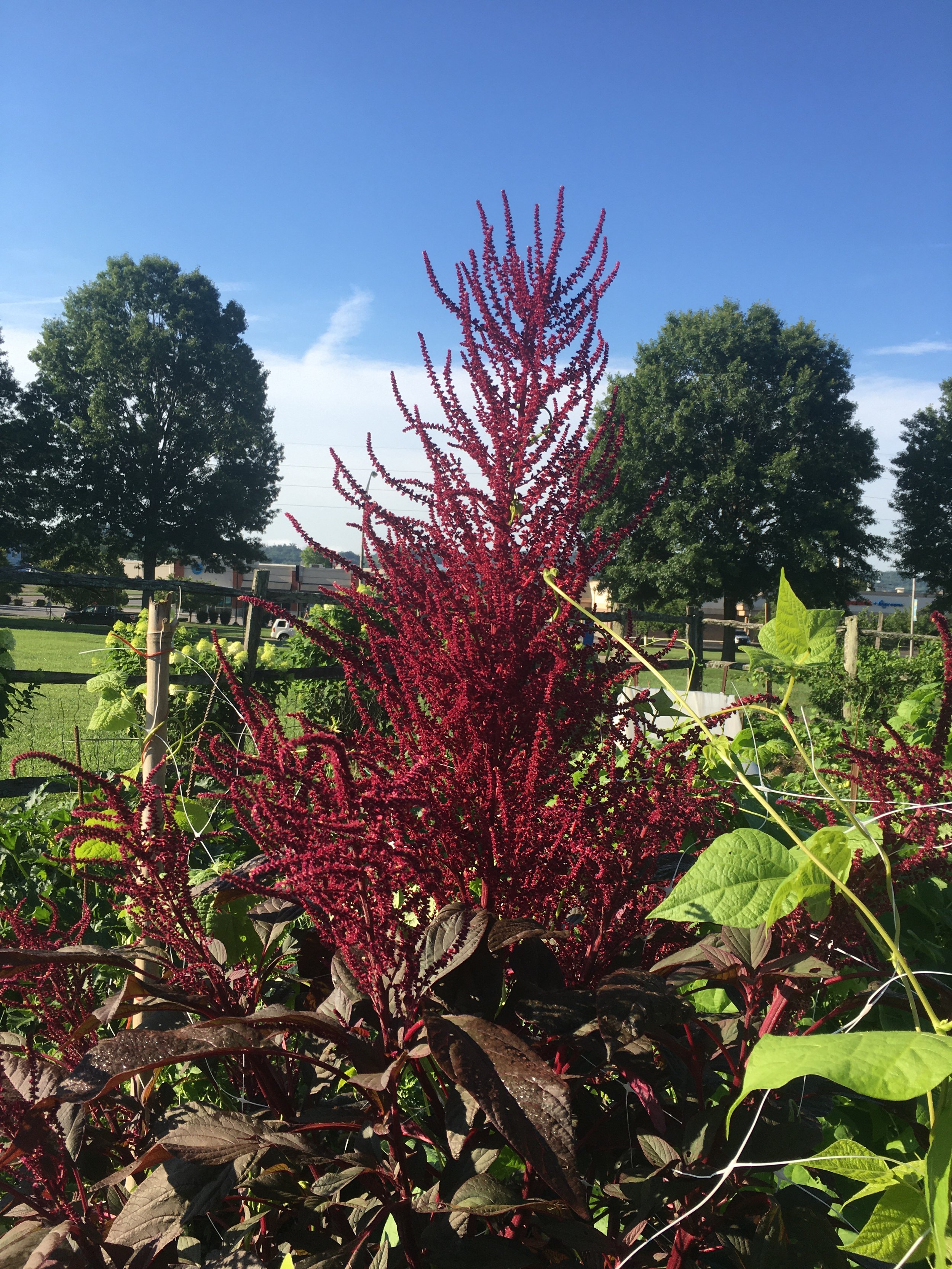
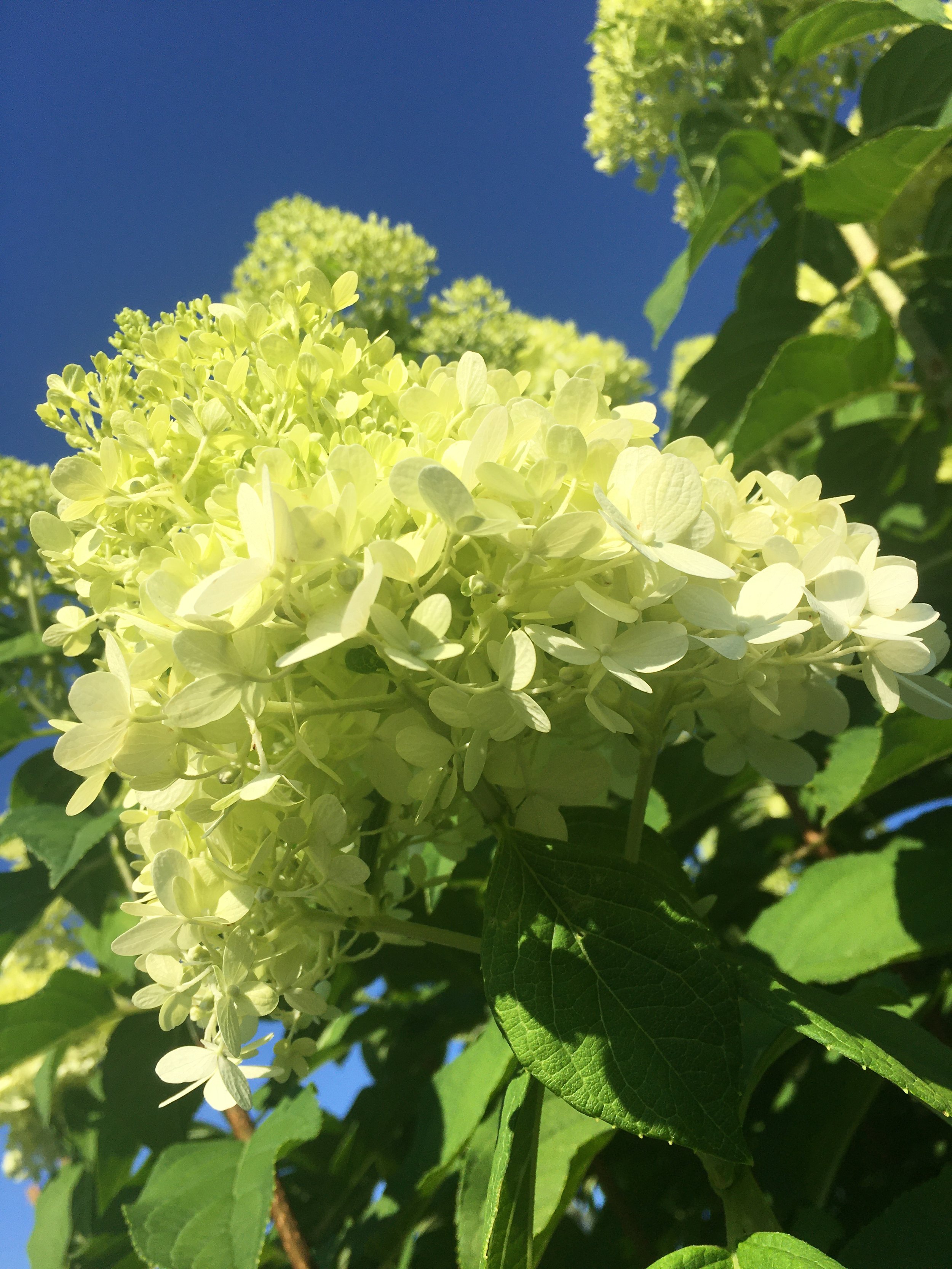
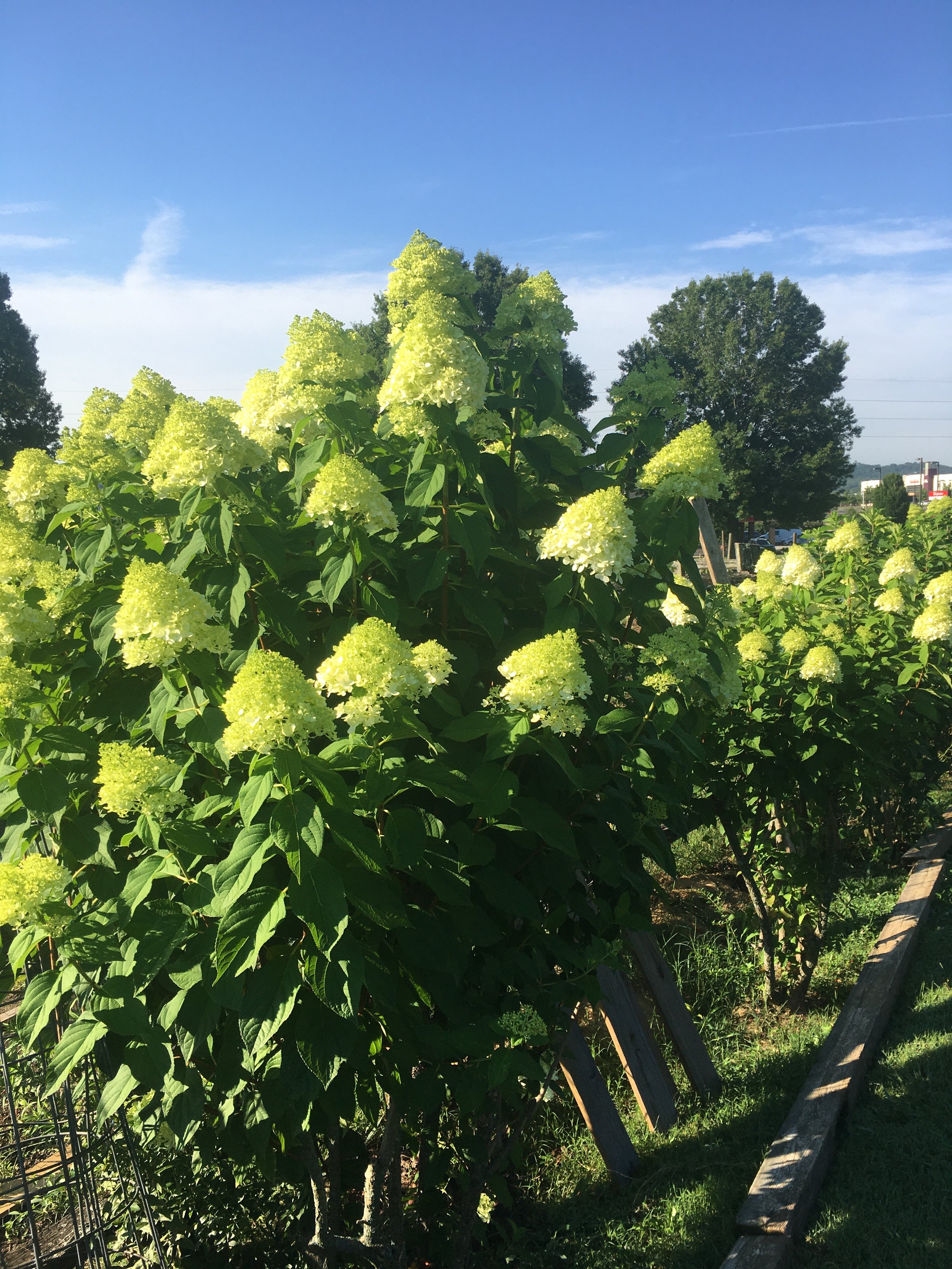
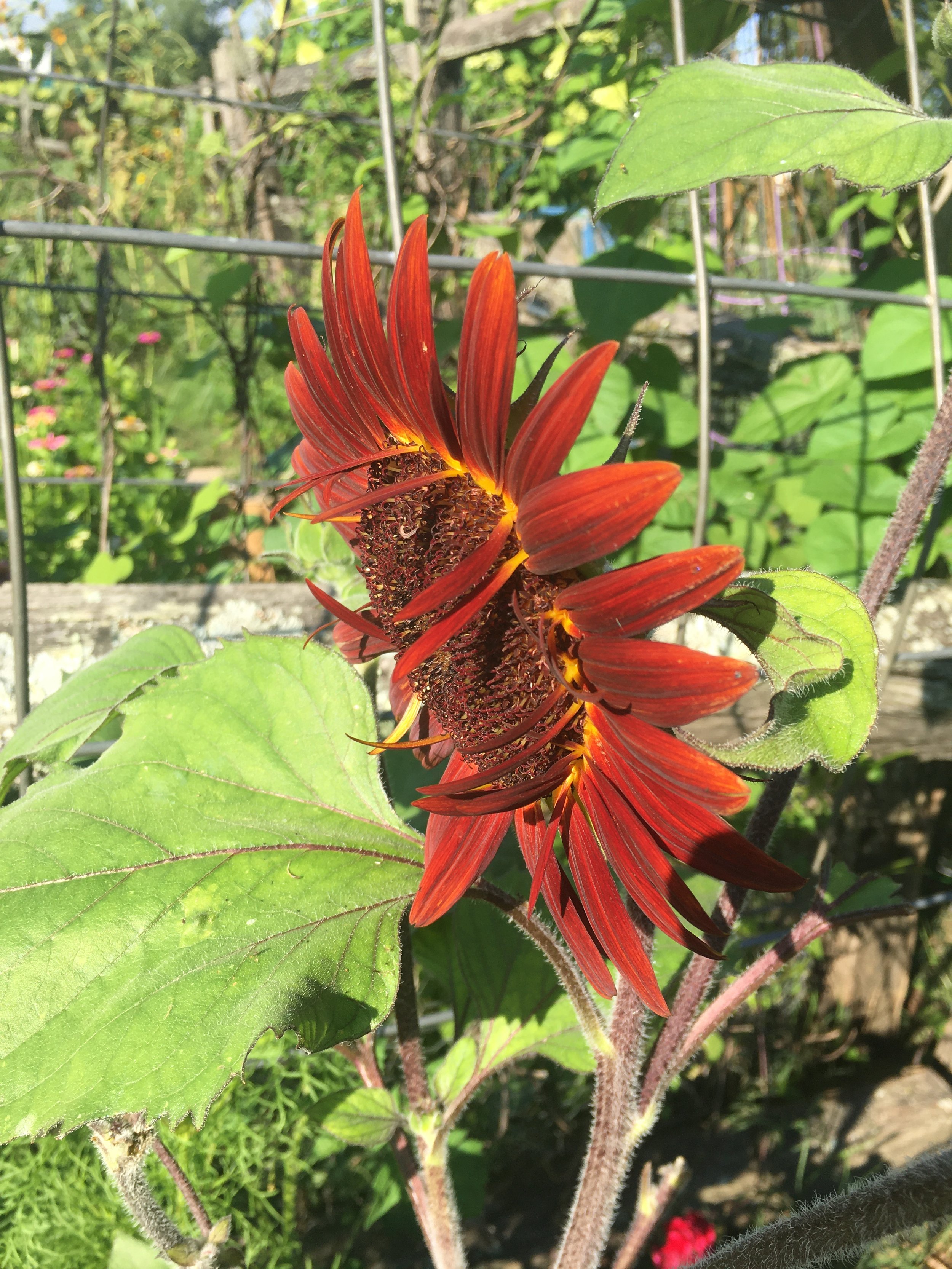

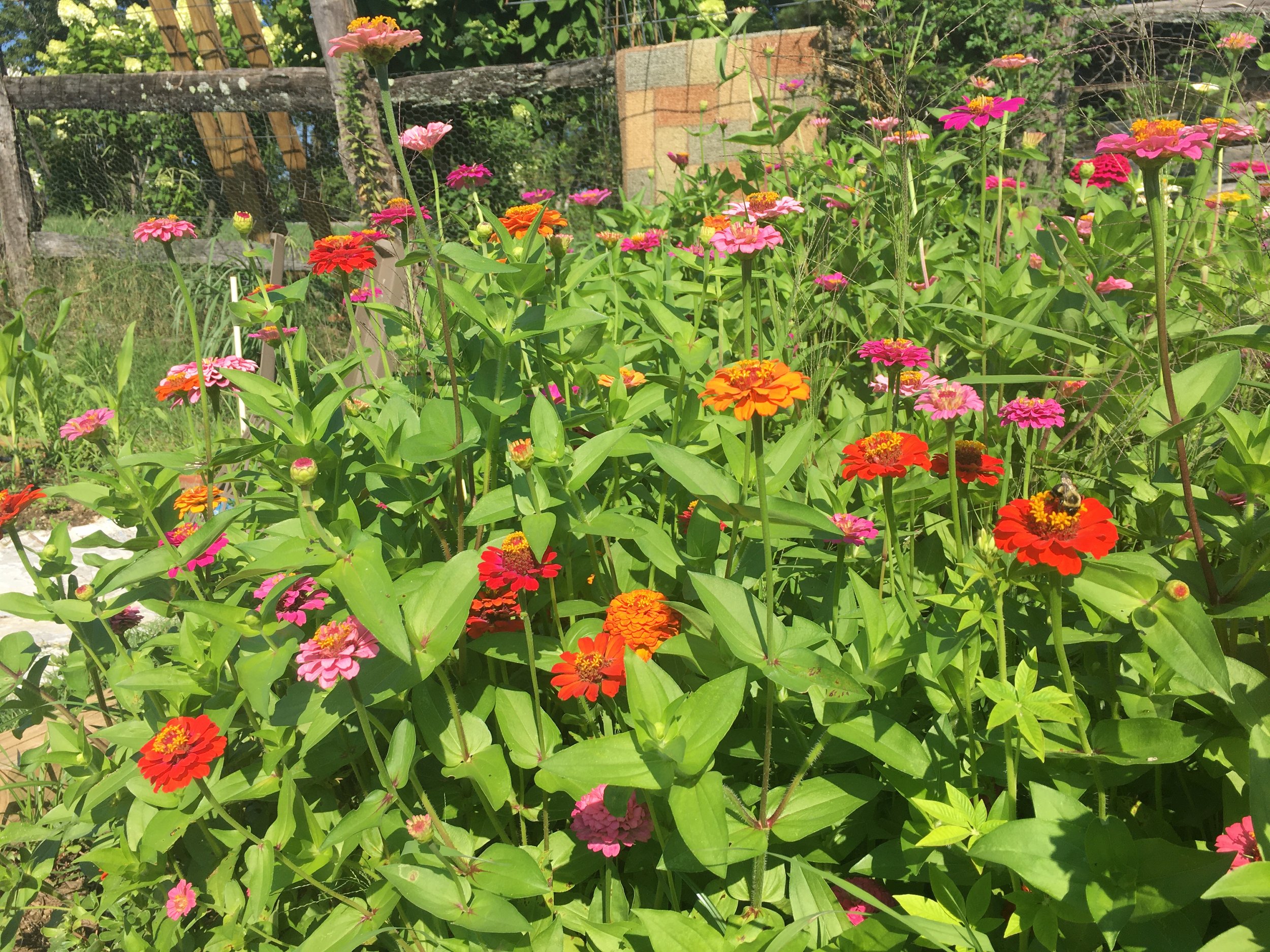
Wish List
-Pieces of brown cardboard for covering weeds. We will cover it with mulch. Plastic tape is ok. Please do not include glossy cardboard. Just drop it off by the gate. We will take care of the rest over time.
-We need leaves, shredded yard trimmings, and straw and grass clippings for compost and mulch (no sticks, no herbicide)
-We are trying to build more than one Johnson-Su Bioreactor (an interesting composting method). We are looking for the supplies listed on their site: How To Build Your Own Bioreactor
Here’s the list of bioreactor supplies. I am sure that we can find most of these locally.
These supplies are for one reactor. We hope to make multiple reactors.
Landscape cloth (woven, minimum 5 oz.): Piece One: 13’ x 6’, Piece Two: 6’ x 6’, Piece Three: 6’ x 6’
One standard, sturdy shipping pallet with dimensions of approximately 40” x 48” We have pallets.
Wire re-mesh (6” x 6” x 10-gauge wire), used to create a 5’ x 12’ 6” supporting wire cage. This type of remesh is normally used for reinforcing concrete. Be sure to use re-mesh as horse fencing or other similar wire fence products have insufficient vertical strength to hold the cage in position as you fill it.
Four 10’ lengths of perforated, bell-end, 4” septic system drain field piping
Tie wire (normally used to tie rebar together)
-If you wish to make a financial donation please mention the St. Mary’s Community garden in the comment section of the donation page at St. Vincent de Paul Society (St. Joseph Food Pantry) .
We do not need any seedlings at this time. But we can help you find a home through our network of growers.
God is good. We have to respond!
God is good all of the time! We have to respond to God’s goodness!
Working in the St. Mary’s garden is an Act of Mercy because we are doing our best to feed our hungry neighbors.
The garden has finally had an abundance of rain. We have too much stuff laying around. Our crops are growing fast. We are blessed. And we are called to be good stewards so please read on…
To help at the St. Mary’s garden:
-We need to find ways to reduce rodent shelter. Let’s find ways to use the leftover wood stash to make things that will help the soil. What comes to mind? Edges for growing areas to keep soil from washing out. Or just dispose of old wood supplies. We are open to ideas. Please be creative and help us find ways to reduce their shelter.
-Let’s also work on the weedy areas near the north side of the garden. We need lots more cardboard. Maybe we need some mulch. What do you think about getting some mulch? Would that make things better or worse? Feel free to let me know.
-We need to reduce food sources: Let’s work on the compost and weed piles. I have a few ideas. Let me know your ideas. I wish we could find a way to get the tomatoes off the ground, but the trellis did not hold up again this year. We need to figure out what’s wrong with our tomato trellis for 2023. I wonder why it worked in 2020, but not in 2021 or 2022.
-If you harvest, please tally your harvest in the notebook. We use these tallies to help us find out if our growing decisions yield good fruit.
-If you harvest flowers, please tally the bunches in the notebook. Share the flowers with people that you love and share His bounty!
To help at the Isidore and Maria garden:
The winter squash vines are HUGE! Some of the weeds got really big especially the “Lamb’s Quarter”. This past week a few of us got down there and weeded little by little. As of last night it looked really good. I think the big vines will keep most of the weeds down in the main growing areas.
Next up at Isidore and Maria: -Keep weeds managed
-Prepare harvest storage areas (it’s going to be a big harvest).
-Get ready for fall cover crops (make a plan and order seeds)
Work days and times:
Evenings are hot, but it’s when I am off work so Jason will work on Monday evening ~6pm this coming week. If you want to get in there and work during the morning cool weather, here are some things to do:
-Harvest cucumbers, squash, tomatoes, peppers and maybe green beans. Make sure to record the harvest and get it into the cooler. Contact Jason for help with this.
-Weed: The areas in the back end of the garden and the front under the compost tumbler need the most attention. If you find lots of cardboard, feel free to spread it over weeds. It will help reduce the overall problem.
The pantry is closed this week, so we do not need to deliver on Wednesday morning.
Please harvest any time you are available. Tally your harvest and follow procedures from previous postings. Communicate if you have questions.
Project leadership opportunities:
—We want to build a Johnson-Su Bioreactor. If this is something you want to help tackle, please stand up and volunteer. We have some funds and supplies and lots of ideas and a few laborers to get started. This might help us control rodents, too. Please step up and pitch in!
—Does anyone want to organize a Saturday morning work time? There is so much to do that you could just let us know that you will be there and I will send out a message to the Google group.
We have almost reached $2000. If you would like more detail about specific crop quantities or productivity over time, please ask Jason S.
Please be the first to harvest zinnias. I have heard that we can cut them and they will continue to produce more and more flowers.
The zinnia patch is just to the right after you enter the garden.
When the pantry is closed, we bring the food to the church narthex and offer to our parish family.
Pests + Harvest and Delivery Procedures
Rodents
Brother Rat digs up and eats our corn before the seeds germinate. We have three traps out. He knows how to spring traps and avoid getting caught. I suspect Brother Rat also likes to eat tomatoes. Here are some of our first ripe victims:
Some creature obviously ate the insides out of these tomatoes.
Harvest Whenever You Are Able
You have two options:
-Bring the harvest home and store it until delivery at 9AM Wednesdays. Please note that the St. Joseph’s Food Pantry is closed until July 20.
-Bring your harvest to the base of main chapel by the social hall. Deposit in the bins and give one of us a call. We will store the harvest in the cafeteria until delivery.
Again, the St. Joseph’s food pantry opens again on Wed., July 20. You are welcome to enjoy your harvest, share it with a friend, or turn it in at the social hall as described above. We will deliver harvests to parishioners for a donation.
Tomatoes and peppers are OK at room temperature. Cold temperatures are not good for tomatoes.
Squash and beans can go in the refrigerator.
You can contact any of us.
You can find these baskets just outside the social hall underneath the main church building.
Watch for our seed saving markers when you harvest tomatoes
If you come across tomato clusters marked with orange twin or pink yarn, please keep those tomatoes separate. We want to save those tomatoes for seed. If you harvest ripe tomatoes that have orange twine or pink yarn, please contact Jason S. so that we can save that seed.
We have a seed saving project happening in our tomato bed. In order to make sure our tomato seeds are “true to type”, we deployed “blossom bags” to avoid cross pollination with wild and volunteer tomatoes in the area. Now that the fruits are setting, we removed the blossom bags and “tagged” the clusters with orange twine or pink yarn so we will hopefully find the same fruits that will set fruit that is “true to type”.
Can you spot the orange twine that marks off this tomato? Probably the Brother Rat ate this tomato already and pooped out our coveted seed!
Greetings St. Mary’s Gardener: Thanks for keeping up with our news. We work hard to serve our neighbors at the St. Joseph’s food pantry with freshly grown food from our garden without depleting our soil resources. Please enjoy our news and stay in touch. Please note our wish list toward the bottom of this message if you would like to donate to our cause.
Work Days
Monday, 7/4: Please come harvest and do a little work on Monday, but the normal 6PM work day is canceled to celebrate Independence day. I plan to go down there sometime in the afternoon or later. I plan on moving okra seedlings to open spots on the row. The target spacing is 2’ between plants. Let me know via text or phone if you want to join me. We always need to weed. Don’t forget to turn the compost tumbler.
The St. Joseph’s food pantry is closed this week. We will not make a Wednesday morning delivery. You may either keep your harvest or deliver to storage according to the harvest instructions above.
With the excessive heat, please work wisely. Bring lots of water and work for short periods of time. It would be best to work with a buddy.
Harvest squash, peppers, and tomatoes any day of the week. Basil does not keep for long, so you can save it for just before delivery.
Here’s the procedure:
-Weigh the basket empty and record the basket weight. (The small white baskets are 0.25lbs)
-Harvest into a basket.
-Load up like vegetables into the basket. Note the final weight and subtract the basket weight. Record the vegetable weight in the notebook by the correct date.
I updated this chart after making a few corrections from last week. I mis-read the data from last week.
Wish List
-We need leaves, shredded yard trimmings, and straw and grass clippings for compost and mulch (no sticks, no herbicide)
-We are trying to build more than one Johnson-Su Bioreactor (an interesting composting method). We are looking for the supplies listed on their site: How To Build Your Own Bioreactor.
Please let us know if you want to volunteer to lead the Johnson-Su Bioreactor project!
Here’s the list of bioreactor supplies. I am sure that we can find most of these locally.
These supplies are for one reactor. We hope to make multiple reactors.
Landscape cloth (woven, minimum 5 oz.): Piece One: 13’ x 6’, Piece Two: 6’ x 6’, Piece Three: 6’ x 6’
One standard, sturdy shipping pallet with dimensions of approximately 40” x 48”
Wire re-mesh (6” x 6” x 10-gauge wire), used to create a 5’ x 12’ 6” supporting wire cage. This type of remesh is normally used for reinforcing concrete. Be sure to use re-mesh as horse fencing or other similar wire fence products have insufficient vertical strength to hold the cage in position as you fill it.
Four 10’ lengths of perforated, bell-end, 4” septic system drain field piping
Tie wire (normally used to tie rebar together)
-If you wish to make a financial donation please mention the St. Mary’s Community garden in the comment section of the donation page at St. Vincent de Paul Society (St. Joseph Food Pantry) .
We do not need any seedlings at this time. But we can help you find a home through our network of growers.
Welcome Warm Weather Crops: Peppers and Squash
Sunflower
Greetings St. Mary’s Gardener: Thanks for keeping up with our news. We work hard to serve our neighbors at the St. Joseph’s food pantry with freshly grown food from our garden without depleting our soil resources. Please enjoy our news and stay in touch. Please note our wish list toward the bottom of this message if you would like to donate to our cause.
The new hand tools are interesting. Please take a moment to try them out and share feedback with the growers around you. Jason S. is especially impressed with the mini-kana hoe.
We made an initial purchase using funds from the Pope Francis Charitable Trust Fund. The red bins are excellent. Please try the new tools and share feedback. Next up we will purchase seed for cover crops. We may purchase supplies for season extension.
Work Days
Monday, 6/27, 6PM or later if it’s too hot. Concentrate on moving okra seedlings to open spots on the row. The target spacing is 2’ between plants. Continue weeding. Don’t forget to turn the compost tumbler.
Wednesday morning delivery and harvest happens whenever volunteers arrive between 8-9:30am.
With the excessive heat, please work wisely. Bring lots of water and work for short periods of time. It would be best to work with a buddy.
Harvest squash, peppers, and tomatoes any day of the week. (Save basil for Wednesday mornings).
Here’s the procedure:
-Weigh the basket empty and record the basket weight. (The small white baskets are 0.25lbs)
-Harvest into a basket.
-Load up like vegetables into the basket. Note the final weight and subtract the basket weight. Record the vegetable weight in the notebook by the correct date.
You may take the harvest home, store it, and deliver on time for the next pantry delivery (Wednesday mornings by 9:30AM). Or you may deposit the harvest by the church social hall and contact a volunteer who know how to access the cooler (Walter, Jason, Deacon Sega, and maybe a few others). They will store the harvest ASAP.
Approximate $ Value is based on the $3/unit for all main crops (greens, lettuce, onions, peppers, roots, and squash) and $2/unit for herbs (basil and cilantro). This helps us keep the crops on an equal footing.
We are moving into our warm season vegetables like peppers, tomatoes, and squash. Greens slowed down dramatically in the hot weather. It looks like they will not outpace the lettuce.
Wish List
-We need leaves, shredded yard trimmings, and straw and grass clippings for compost and mulch (no sticks, no herbicide)
-Work gloves for little people and children
-We are trying to build more than one Johnson-Su Bioreactor (an interesting composting method). We are looking for the supplies listed on their site: How To Build Your Own Bioreactor
Here’s the list of bioreactor supplies. I am sure that we can find most of these locally.
These supplies are for one reactor. We hope to make multiple reactors.
Landscape cloth (woven, minimum 5 oz.): Piece One: 13’ x 6’, Piece Two: 6’ x 6’, Piece Three: 6’ x 6’
One standard, sturdy shipping pallet with dimensions of approximately 40” x 48”
Wire re-mesh (6” x 6” x 10-gauge wire), used to create a 5’ x 12’ 6” supporting wire cage. This type of remesh is normally used for reinforcing concrete. Be sure to use re-mesh as horse fencing or other similar wire fence products have insufficient vertical strength to hold the cage in position as you fill it.
Four 10’ lengths of perforated, bell-end, 4” septic system drain field piping
Tie wire (normally used to tie rebar together)
-If you wish to make a financial donation please mention the St. Mary’s Community garden in the comment section of the donation page at St. Vincent de Paul Society (St. Joseph Food Pantry) .
We do not need any seedlings at this time. But we can help you find a home through our network of growers.


